















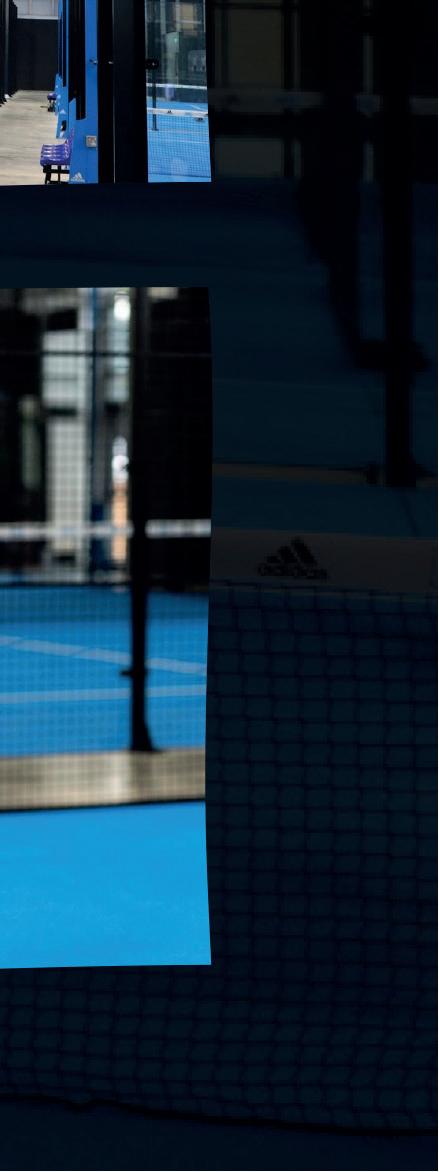

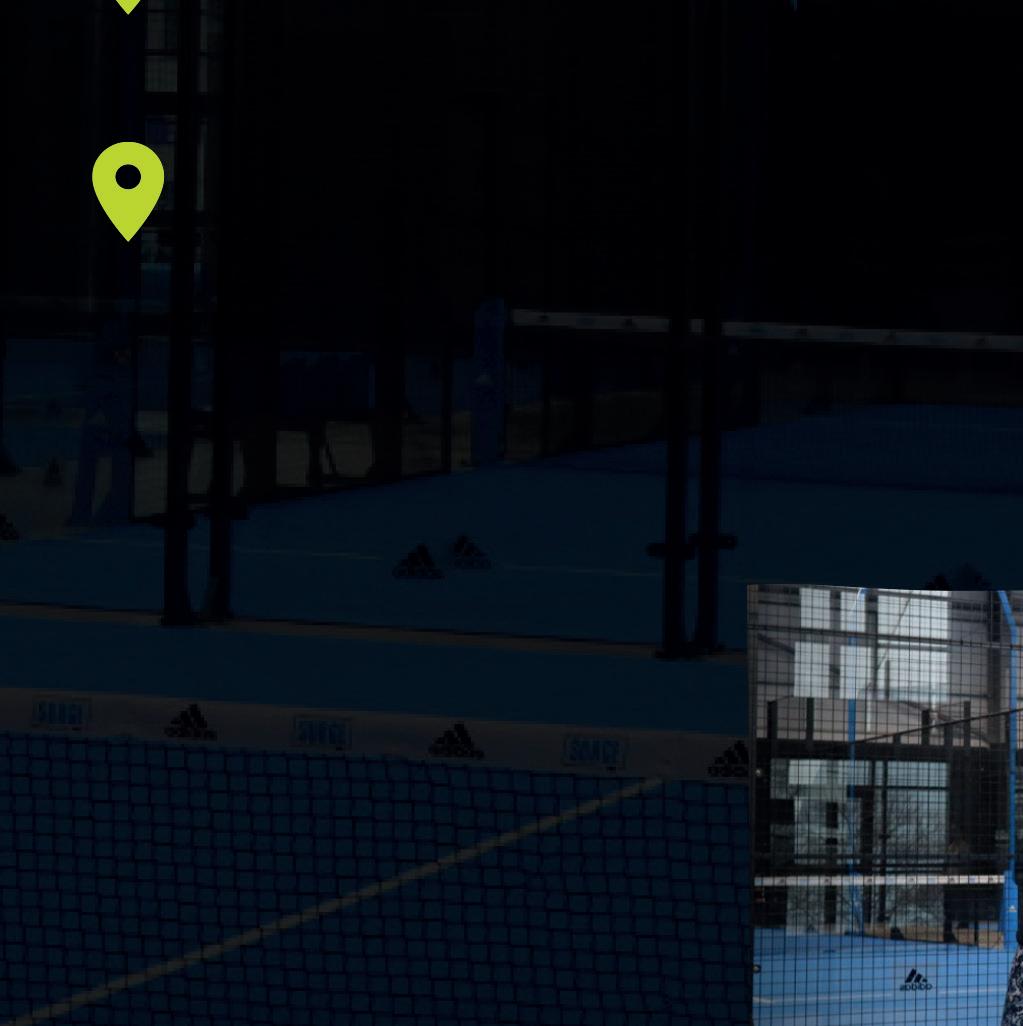





FOURTH AVE, HORNBEAM PARK AVE, HARROGATE HG2 8QT 01423 224 752
UNIT 1, LODGE CAUSEWAY TRADING ESTATE, FISHPONDS, BRISTOL BS16 3JB 0117 450 5199
All our structures conform to the relevant building codes and we are SAPCA approved.
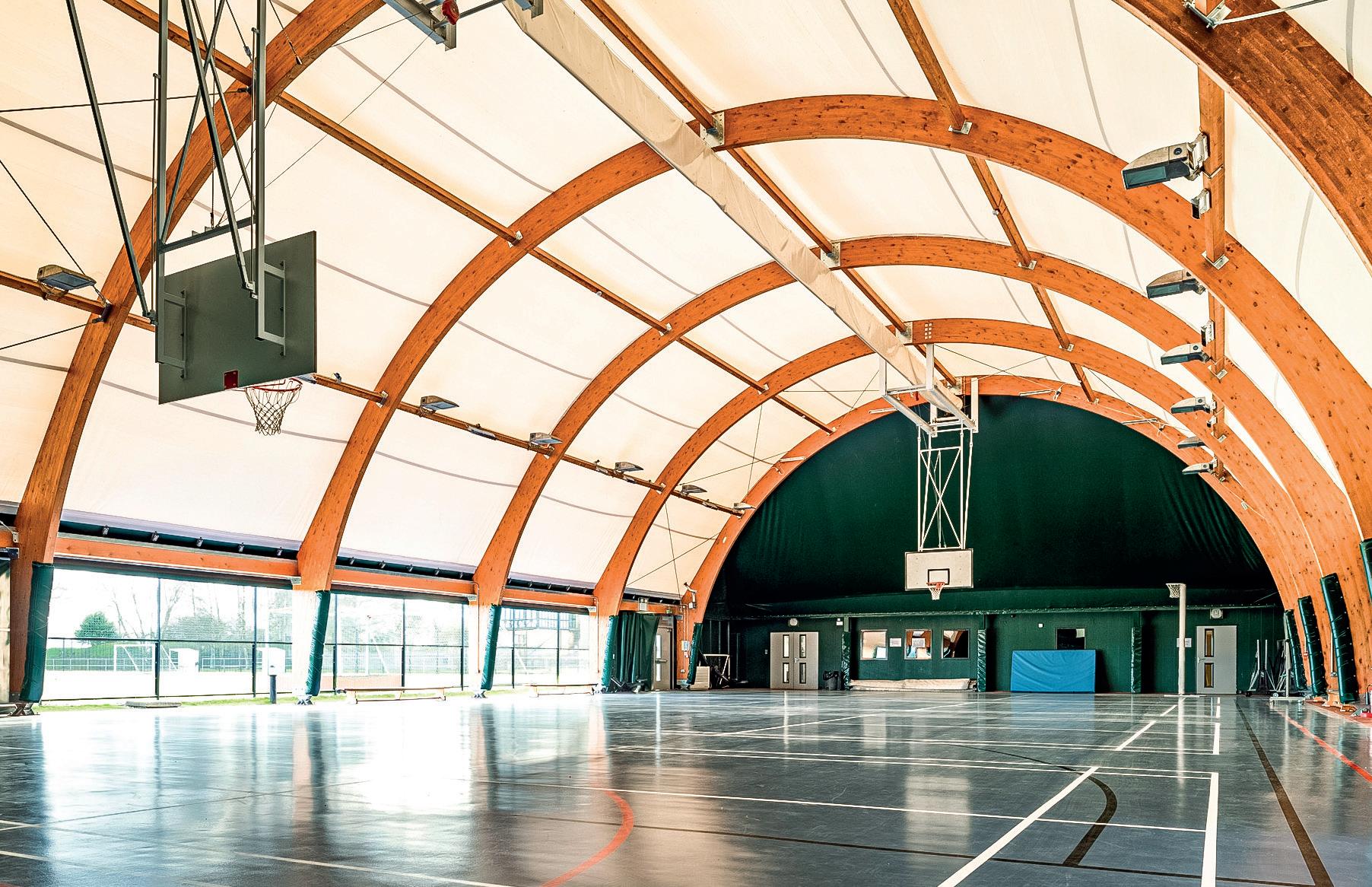
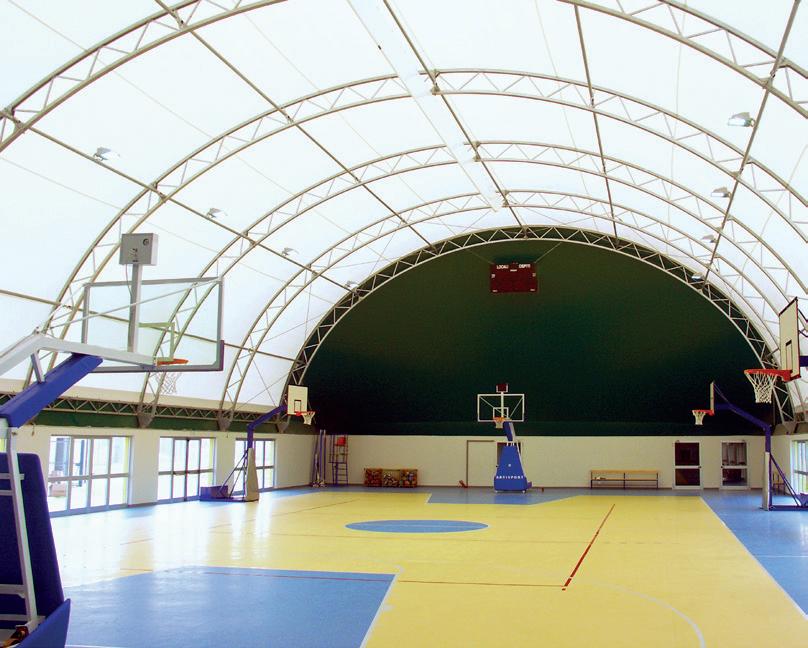

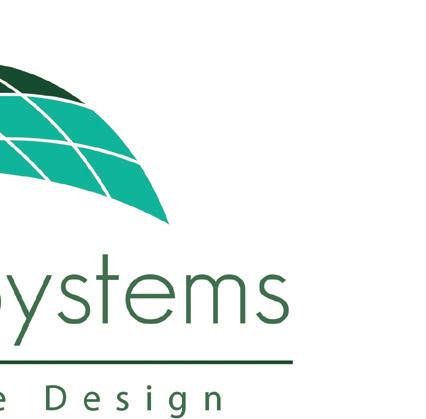




Agateway into tennis, an easy to pickup activity for everyone and a sport in its own right enjoyed at all levels from casual player to elite professional. Padel is all of this and more, which is why it’s enjoying such a high level of interest and rate of growth across the country.
If the sport’s success in other countries is anything to go by, it will only be a matter of time before most towns in the country have their own courts. While many clubs are adding, or planning to add, padel to their offering, some of the leading facility operators have already established themselves at the forefront of padel innovation and commercial success. On the public side of things, there are a number of councils supporting bids to introduce padel courts into communities. With a myriad of options available for those looking to introduce padel into their facility,
club or community, our Growing the Game feature, sponsored by Surge Padel (see pp. 44-54) is a great place to find out more about the UK’s biggest buzz sport. In this issue, we also take a closer look at two crucial aspects of sports facility development – lighting and playing surfaces. There are a number of reasons why, in recent years, LED solutions have become the preferred choice for sports facilities looking for a lighting system. Of these, the lower running cost is perhaps the most significant. In a time of everincreasing energy prices, it is no surprise that facility operators are looking for ways to bring down their outgoings – even if it means a higher initial investment.


Economic, as well as environmental, sustainability is at the front of mind for many operators, as we hear from Jo Cherrett, CEO of Trafford Leisure. You can read her thoughts on the issue from pages 38 to 42.
 Tom Walker Editor
Tom Walker Editor


T: +44 (0)7796 512769

E: tom@sportsnation.org.uk

32 SAPCA 2023 Awards winners

The winners of the prestigious awards this year include an innovative recycling solution
38 Interview: Jo Cherrett
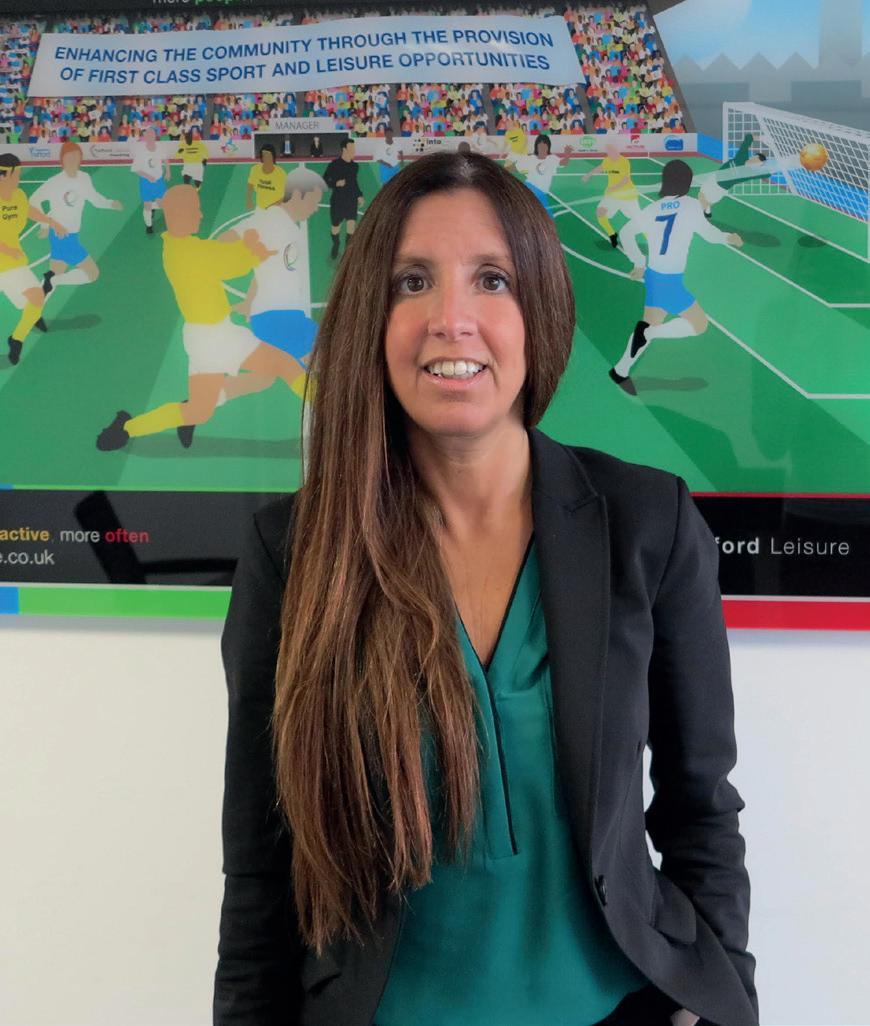
The CEO of Trafford Leisure describes the company’s new ‘move’ brand and outlines the challenges faced by the sector



44 Growing the game: padel
72 Sports lighting
In association with Surge Padel
An in-depth look at how the sport of padel is growing rapidly in the UK

58 Top Team: Football Foundation

The foundation has directed £1.8bn into grassroots sport since 2000. SportsNation speaks to the people who make the funding body tick

68 Sports surfaces
A look at recent sports projects and the choice of playing surfaces
LED solutions are becoming increasingly popular for sports facilities. We look at some recently completed projects
78 SAPCA Showcase
Members’ classified directory - find your next sports facility project partner
82 Interview: Nick Roche
Nick Roche, project manager at SAPCA member O’Brien Contractors, talks about his role




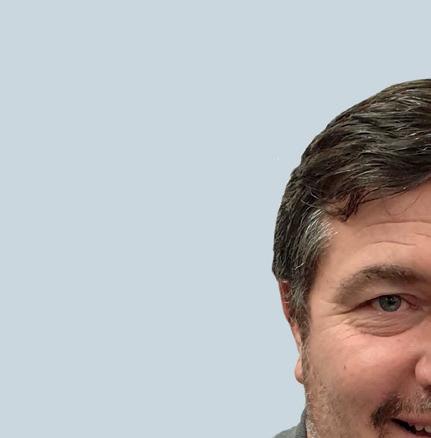







































A first of its kind recycling facility and an innovative new product set to transform tennis training were among the SAPCA Awards 2023 winners. Now in their eighth year, the awards celebrate the achievements of SAPCA members across the sports and play facility construction industry. To read more, turn to page. 32
A new Sport England report shows how physical activity could be better used within the NHS to help improve mental health outcomes. The report highlights some of the barriers which currently prevent physical activity being routinely used in treatment.
The government has earmarked £63m to support publicly-owned swimming pools and leisure centres.

Coinciding with the Spring Budget, the announcement was made as part of plans to relieve pressure caused by high fuel bills.
The fund will be managed by Sport England and will be available to all facilities operated by local authorities – as well as those run on behalf of councils by contractors and charities.
Tim Hollingsworth, CEO of Sport England, said: “This is a significant and welcome amount of support from the government that will offer a lifeline to many public leisure centres across England, as well as help sustain them into the future.”
There are more than 2,000 public leisure centres in England, of which around 800 have a swimming pool.
It is believed that, since October 2022, more than 350 facilities have already been forced to cut services.
Physically active teenage girls (aged 15 to 18 years old) do better academically than their inactive peers. A study by the University of Illinois found that girls who take part in physical activity each day have better attentional control than sedentary teenagers, who were “slower and less accurate”.
Mel Bound, Michelle Cracknell, Jason Fergus and Helene Raynsford have been appointed on the board of Sport England for terms of three years, running until 31 December 2025.
Bound is the founding chief executive of This Mum Runs, a digital, mobile and in-person running community for women. Cracknell was chief executive and accounting officer of The Pensions Advisory Service from October 2013 to December 2018. Fergus is director of Active Essex, one of the largest Active Partnerships in England and heads up the delivery of the Essex Local Delivery Pilot.

Raynsford is a retired Paralympian having become the first world champion and Paralympic rowing gold medallist in women’s single sculls.

Kim Leadbeater has called for health and wellbeing to be at the heart of all government policy making. The Labour MP for the Batley and Spen constituency says government departments should work much more closely together as part of a “major transformation of health services”.
She makes the call in a new report called Healthy Britain:
A new approach to health and wellbeing policy.
The report argues that, just like policy is now evaluated through a ‘green lens’ for environmental sustainability, a ‘health and wellbeing lens’ should also be applied during decision making.
It also calls for putting physical literacy and wellbeing at the heart of a ‘curriculum for life’.

Girls as young as five years old are made to feel as though sport is not a place for them, according to research from charity Women in Sport.
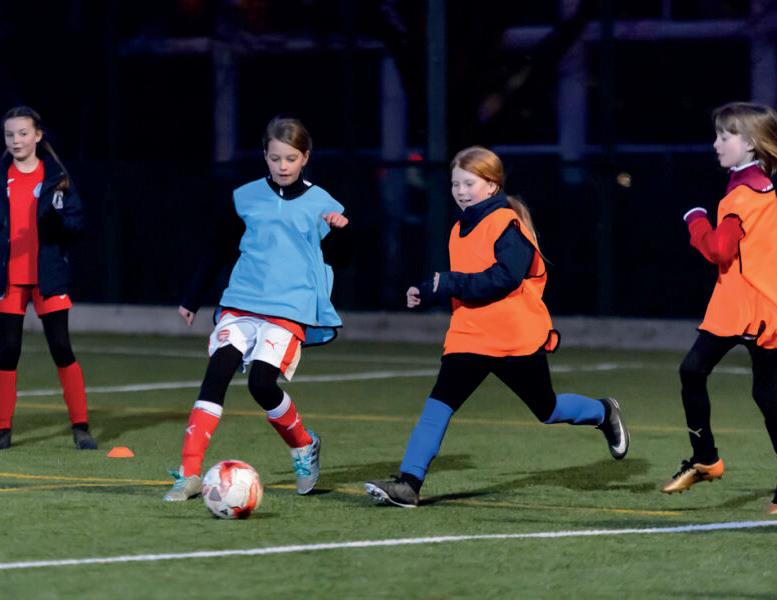
Released to coincide with International Women’s Day, the report shows how girls are being bombarded by messages and labels that undermine their self-belief, crush their confidence and imply that they are not as competitive or as good at sport as boys.
The report, called Sport, stereotypes and stolen dreams: Why girls still feel they don’t belong in sport, found girls are heavily influenced by parents, family, peers and the school environment,

with marketing and media playing more of a role as girls get older.
Young girls are internalising gender stereotypes and negative messaging which can make them feel as though there is limited value in taking part in sport.
Girls are heavily influenced by parents, family and peers
The number of adults playing tennis in Great Britain increased by 43% in 2022, rising from 3.3 million to 4.7 million. The figure comes from the sport’s national governing body, LTA, which says the numbers mark the highest total recorded since 2017.

According to LTA, participation numbers also show that more than two million adults now play tennis monthly, another record high.

Participation among 1634 year-olds jumped 48 per cent in the year – more than any other age category.
LTA Chief Executive, Scott Lloyd, said the increases
were a result of a concerted effort to make tennis more accessible and welcoming.

These include investment in booking systems to make it easier for people to find local opportunities to play, the roll out of a LTA Youth programme and a £14.3m investment –through grants and loans – in new facilities across Britain
“At the LTA, our vision is tennis opened up and we’ve worked hard to put solid foundations in place to make tennis more accessible,” Lloyd said.
“We have a fantastic network of coaches, volunteers, clubs and park courts.”



Multidisciplinary consultancy specialising in inclusive, multi-sport areas and playzones










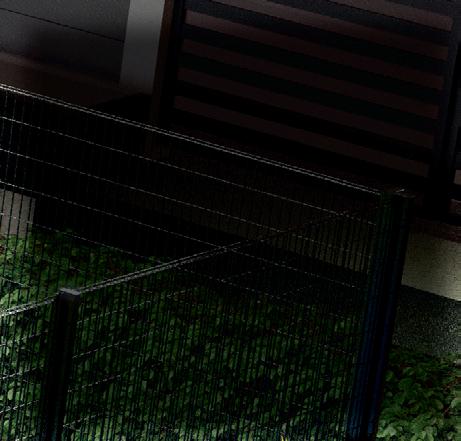




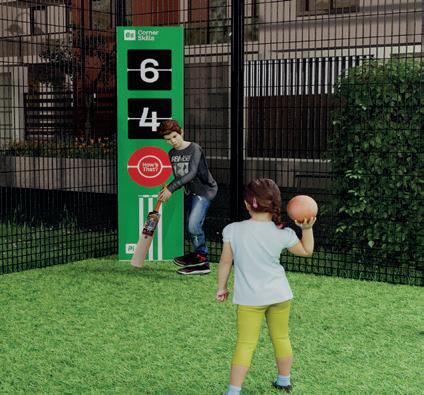

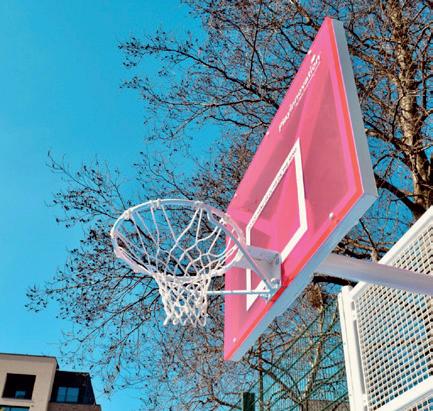






























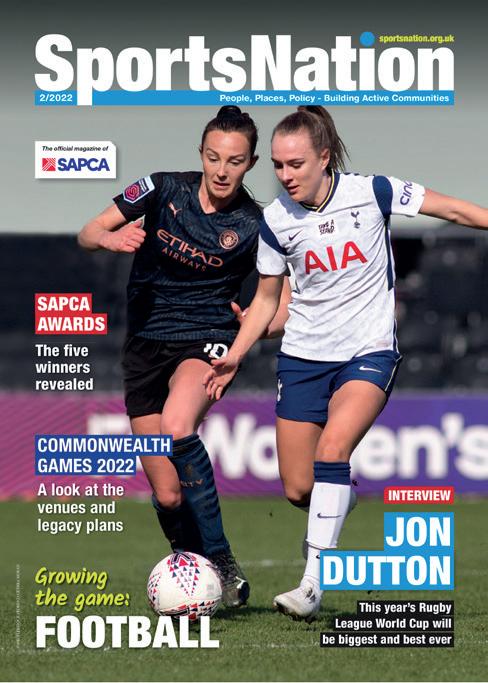





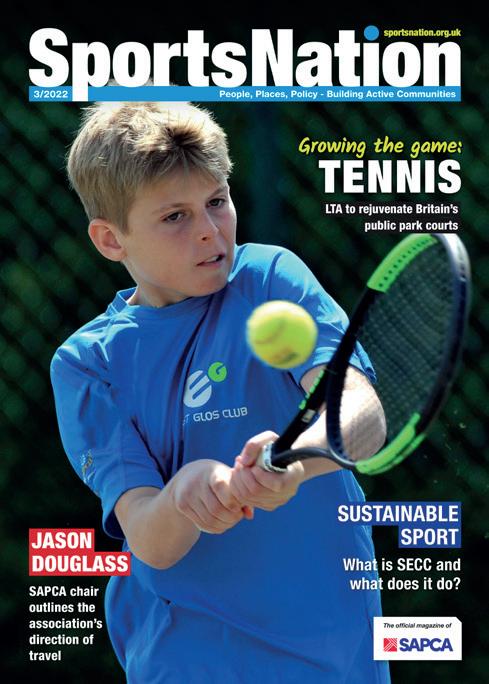








This Girl Can – the campaign to inspire more women and girls to take part in sport and physical activity – has moved into “a new phase”.
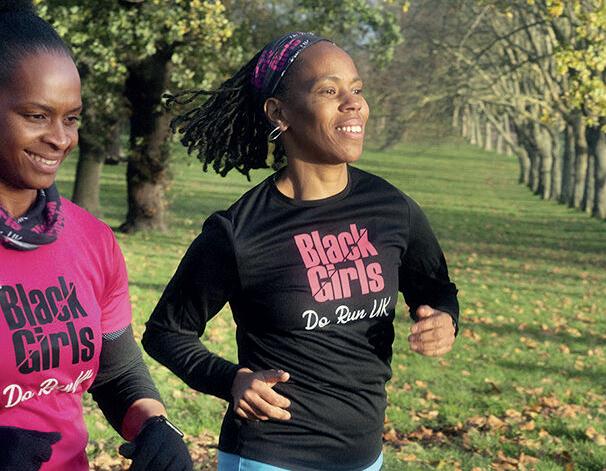
The award-winning initiative, first introduced in 2015, has expanded its mission with the launch of This Girl Can With You. With the new tagline, the campaign will focus on breaking down the barriers that mean women remain less likely to be physically active than men. According to Sport England research, 2.4 million fewer women than men currently find sport and exercise enjoyable and satisfying.
When it comes to the practical and emotional barriers preventing women from getting
active, fear of judgement prevails, with key concerns for women including worries about not being fit enough (41%), what other people think of them (32%), showing their body (31%), being on their period (24%) and wearing tight clothing (20%). More than a third (38%) of women say they have felt judged when exercising.
Kate Dale, Sport England’s director of marketing, says that, as enjoyment is one of the biggest motivators for people to take part in sport and physical activity,
closing the “enjoyment gap” is an important step towards closing the gap in participation levels.
“The enjoyment gap is yet another inequality between women and men,” Dale said.


Swim England has partnered with the Royal College of GPs to launch a initiative promoting the “transformative power” of being active in water.
The new ‘Swimming as Medicine’ initiative includes a series of videos highlighting the benefits of swimming. The videos will focus on how healthcare professionals should consider recommending swimming and aquatic activities to their patients, as they can sometimes be ‘far more powerful’ compared to other healthcare interventions.
The first video features Dr Hussain Al-Zubaidi, who shares his thoughts on the power of swimming.
He also offers suggestions to other healthcare professionals on how to have physical activity conversations around swimming with their patients.

A £19.5m community sports fund has been launched to help under-served and vulnerable young people to access and enjoy sport and physical activity.
The new Go! London fund aims to invest at least £10m into grassroots sport and physical activity initiatives in the capital by 2025, transforming the lives

of Londoners aged 4 to 24 years old. Sport England provided £7.5m of National Lottery funding for the programme, with London Marathon Events doing the same and the Mayor of London adding £4.5m.
Charities, youth groups, social enterprises and faith groups can now apply for grants from £40,000 to £150,000, to improve existing sport and physical activity programmes or deliver new services.
Lisa Dodd-Mayne, Sport England’s executive director of


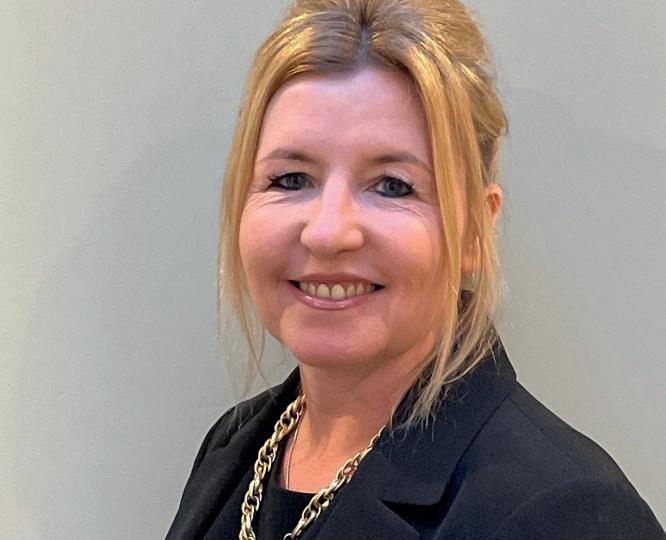
place, said: “The Go! London fund supports our aim of increasing activity, decreasing inactivity, reducing inequalities and improving the positive experience for children and young people.”
Leisure facility management company Parkwood Leisure has taken over the operations of Plas Menai, the National Outdoor Centre for Wales.
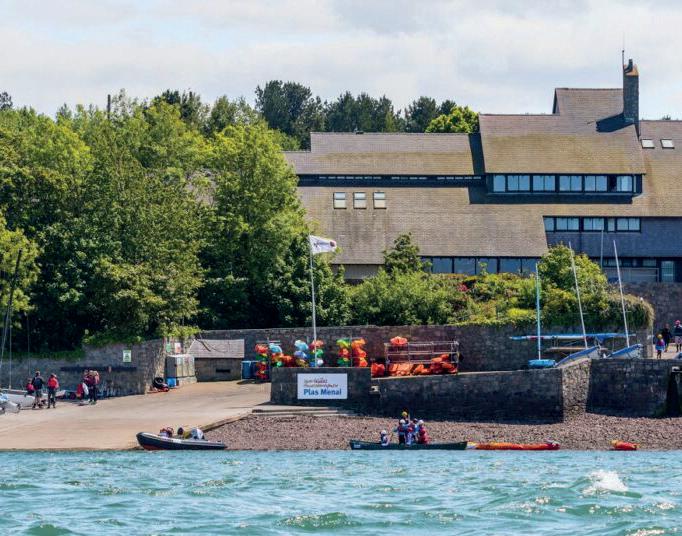
The new contract will see Parkwood Leisure take on the day-to-day running of the Centre for an initial 10-year period.
The buildings and land will continue to be owned by Sport Wales and all existing staff will remain employed at the site.
As part of the agreement, a strategic partnership group – comprising representatives from Sport Wales, Parkwood Leisure, and staff at Plas Menai – has been set up to focus on growing and enhancing the current sports and leisure services, and supporting staff with the transition.
The government has pledged to offer girls and boys the same opportunities to play sports during PE and extracurricular time in schools. In a move that it says will “develop new standards for equal access to sports”, the government is providing a package of funding to help boost sport and activities both inside and outside school hours.
The funding includes £600m over the next two academic years for the PE and Sport Premium and £22m for the School Games Organisers (SGO) network. Schools that successfully deliver equal opportunities for girls and boys will be rewarded

through the School Games Mark, which will assess parity of provision in PE and extracurricular sport. Schools are also being asked to offer a minimum of two hours curriculum PE time and government will provide support to schools on how to do this through the upcoming refresh of the School Sport Action Plan.

Alongside this work, Ofsted will be publishing a report into PE in the coming months, which will inform future inspections and set out what they believe is possible in terms of offering high quality PE and equal access to sports.


Sport Wales has announced a new package of capital funding worth £3.1m.
The funding has been earmarked to provide more sporting opportunities, as well as help safeguard the longterm future of leisure facilities by making them more energy efficient and sustainable.
One of the projects to receive investment from the funding will see new solar panels being installed at Gwyn Evans Leisure Centre in Wrexham, thanks to a £230,817 award to help make the facility more sustainable and more cost effective.
The grant will reduce the leisure centre’s energy bills so that it can continue to be affordable for people in the local area.
Elsewhere, a £90,000 grant will enable Amlwch Leisure Centre to be revamped, so that local people can continue to enjoy a range of sports. The funding will mainly be used to replace the flooring in the main hall of the 1970s facility.
A further £99,000 will be spent on new netball courts and floodlighting in Bridgend. Subject to planning permission, the new facility will support community women and girls’ programmes in the area.
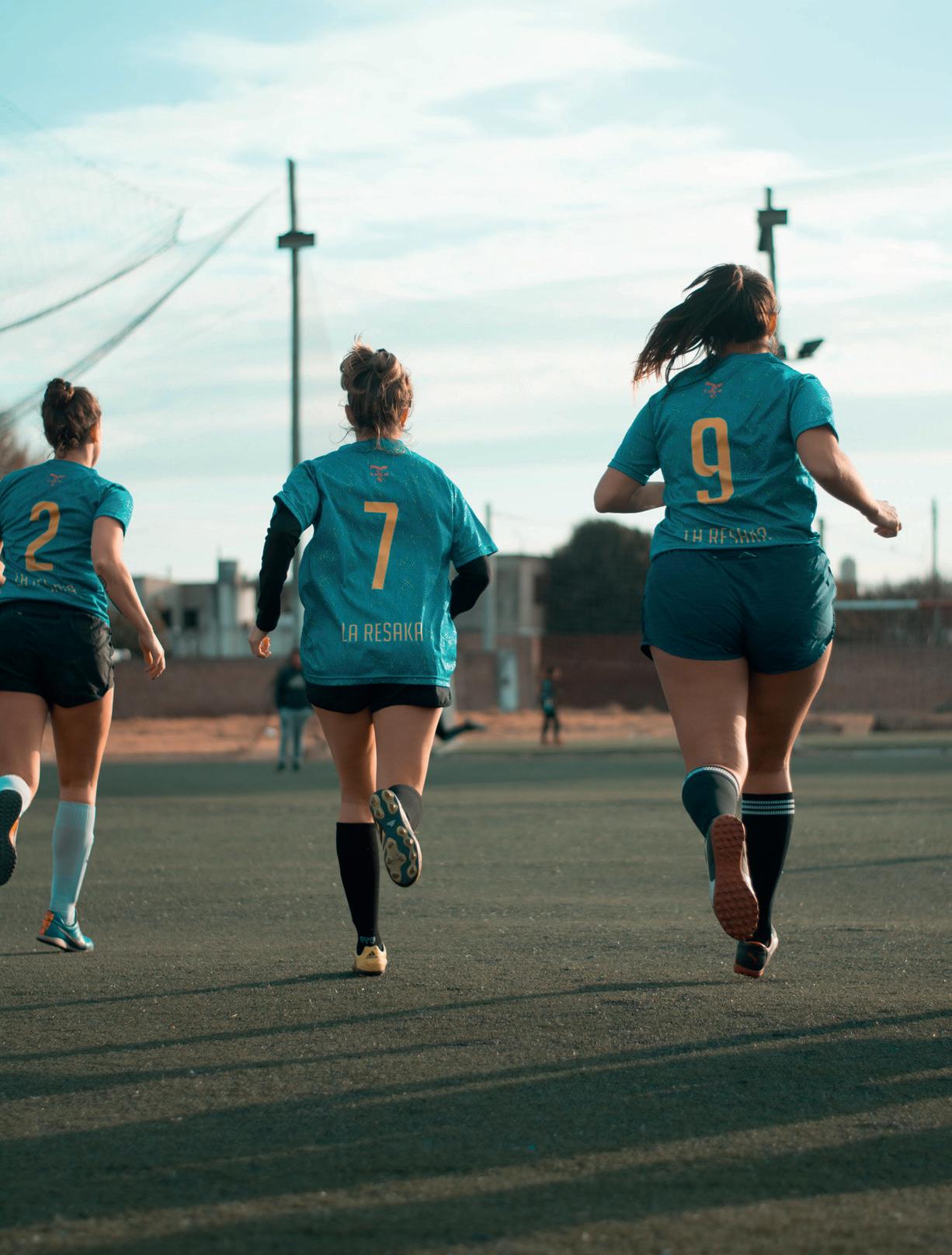

Getting the population of Europe to achieve the recommended physical activity levels could save the EU economies €14bn in health costs by 2050 – equivalent to the total annual health care expenditure



The finding comes from a report called Step up! by the World Health Organization (WHO) and OECD, which analyses the burden of inactivity on the 27 EU member states.
It shows that if recommended minimum of 150 minutes of exercise levels were reached weekly, it would cut 11.5m new cases of noncommunicable diseases (NCDs) by 2050. If levels were upped to 300 minutes per week, it would prevent a further 16m cases of NCDs. As a result, the report calls on policymakers to step up their policy response to increase physical activity.
Especially for artificial turf sports grounds: The Trocellen XC & XC Plus series includes high-quality shock pads made of closed-cell, chemically cross-linked polyethylene foam. ProGame shock pads are delivered in rolls of 2-meter width and tailored length to meet the requirements of the field. The combination of the unique XC-punched polyethylene foam guarantees excellent drainage properties, quick and easy installation, and very high dimensional stability. The wide range of thicknesses (6 – 14 mm) and densities (30 – 90 kg/m³) caters to the requirements of a variety of sports.






Blakedown are one of the largest sports facility contractors in the country. We require an enthusiastic and self-motivated person, ideally with a sports and / or civils engineering background to join our existing team.


An excellent remuneration package offered for the right candidate, including flexible hours & option of working from home.
Please apply in writing or by e-mail enclosing your c.v. to:

Avi Natan – Director
Blakedown Sport and Play Limited
Unit 1, Foley Business Park, Stourport Road, Kidderminster, DY11 7QL
avi.natan@sportandplay.co.uk
www.blakedown.co.uk
Blakedown Sport & Play is an equal opportunity employer
Employers within the sport and physical activity sector need to do more to support the mental health of their workforces.
That’s the main message of The 2023 Workforce State of Mind Survey, which shows that there is a widening gap between the needs of the workforce and the protection and support provided by employers.
More than half of the respondents to the survey said they had experienced a mental health issue in the past 12 months, while nearly three-quarters say they’ve experienced a mental health issue ‘at some point’.

However, just 8 per cent of respondents said somebody regularly checks on their mental health at work – down from 11 per cent in 2022 and 19 per cent in 2021.


Employees within sport and physical activity need more support with their mental health
On the positive side, 72 per cent of respondents with a line manager felt their manager cared about their mental wellbeing. The figure has remaind at this level for three years (75 per cent in 2022 and 78 per cent in 2021).
Now in its third year, the survey was conducted by Workplace Mental Wealth and is based on responses from 918 individuals working within sport and active leisure across the UK, as well as 68 employers.
The funding will o er help to facilities which have su ered from flooding
Sport England’s Small Grants Programme is now accepting applications from organisations in areas hit by floods which need funding to repair damage.
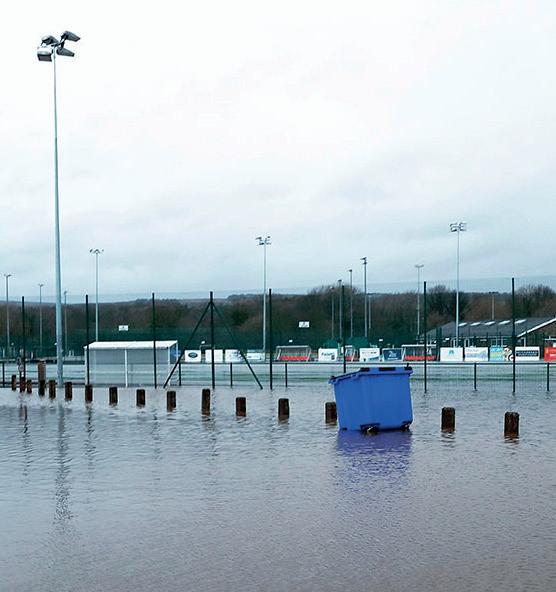
The funding will be focused on those areas most badly affected, with Sport England prioritising sports that “need to return quickly”.
Previous recipients of emergency funding from Sport England for flood or storm damage that are now applying again will need to show they have developed a Flood Plan if advised to do so in their previous award.
The funding is designed to help with emergency costs to help restore sports facilities and will cover minor works, such as securing buildings and structures, electrical works to restore power, skip hire to remove sediment and rubbish and cleaning work to get changing rooms operational.

We live in interesting times. The disruption and social upheaval of the past few years – Brexit, the pandemic, climate activism and the MeToo and Black Lives Matter movements – have armed society with a renewed focus on the importance of health (both mental and physical) and the need to tackle inequalities and injustice.
This new drive for equality and health on a societal level has also filtered into grassroots sport and play.
As a direct result, many of the recent investment programmes launched by national governing bodies and other funding organisations have been geared towards providing opportunities for those who need the most help to become active – such as people from some BAME communities, those with disabilities, women and girls and people from lower socio-economic groups.
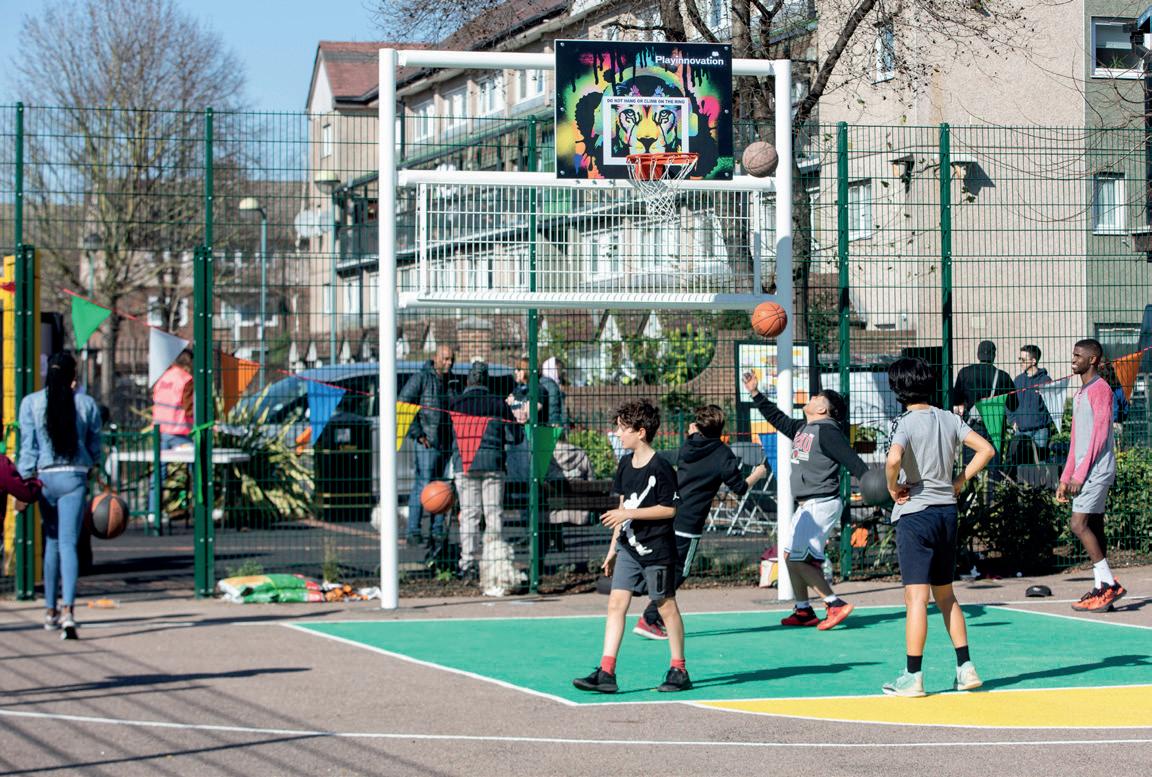

At the core of this shift has been a realisation that venues need to cater for people of all ages and abilities. The preferred solution to provide this has been to begin creating facilities which can house a multitude of sports and activities.
About time too. While it is right that investment needs to be directed at “traditional” sports facilities, there is a danger that sport can be seen elitist. For example, 3G pitches or tennis courts that aren’t open to the public and where players have to pay to play might exclude those who would benefit from using them the most – the physically inactive who lack the confidence to take part in organised sport.
Could the traditional approach, to only invest in facilities which cater for specific sports, be the reason that the percentage of the population which is physically active (according to Sport England figures) has stubbornly remained the same for 20+ years?
With all of the outcomes we need to meet today, it is now time to adopt a more innovative approach to how facility funding is distributed. It is the only way we can meet important targets relating to inactivity, inequality and the cost of living crisis.
The big question is: how do we best reach the diverse and wide demographic of inactive people? At Play Innovation, we’re excited where the
conversation is headed. We hope that innovation is at the forefront of a new approach, along with flexibility and fearlessness. A new approach, which is prepared to try new ideas, instead of redelivering the model tried for the past 20 years
But while there is clearly a new-found desire to create facilities that can host a range of sports and activities – in the hope that they attract people of all backgrounds – are we doing enough to actually deliver what is needed? It’s easy to describe a caged ballcourt with line markings for more than one sport as “multi-use”. But if there’s a pair of football goals, will it ever be used for more than football? By anyone other than teenage boys? Are MUGAs ever going to be used by the people that we really need to reach? Those who are nervous about taking part in organised sport, due to their background, ability or some other personal reason?
The truth is that some of the most successful initiatives tackling inactivity take part in smaller-scale, pocket-size facilities with no organised sport in sight. Providing informal, fun-driven activities, these are the true multiuse areas – because they are “multi-user”
facilities. They are areas in which parents, children, teenagers and grandparents of all backgrounds and abilities can come together.
Play Innovation was launched in 2010 to provide exactly these types of facilities – environments which engage, inspire and bring communities together. We recognise that, to truly reach those who would benefit most from getting physically active, we need to do something differently. There is a need to make sport and play more inclusive. More informal and more fun.



Our mission has always been to create safe and inclusive spaces for those who benefit from them the most – people, young and old, who might be nervous about taking part in organised sport.
We thrive on creating environments in which everyone can experience the feeling of success that helps provide a healthy, lasting relationship with sport and physical activity.

More info: www.playinnovation.co.uk
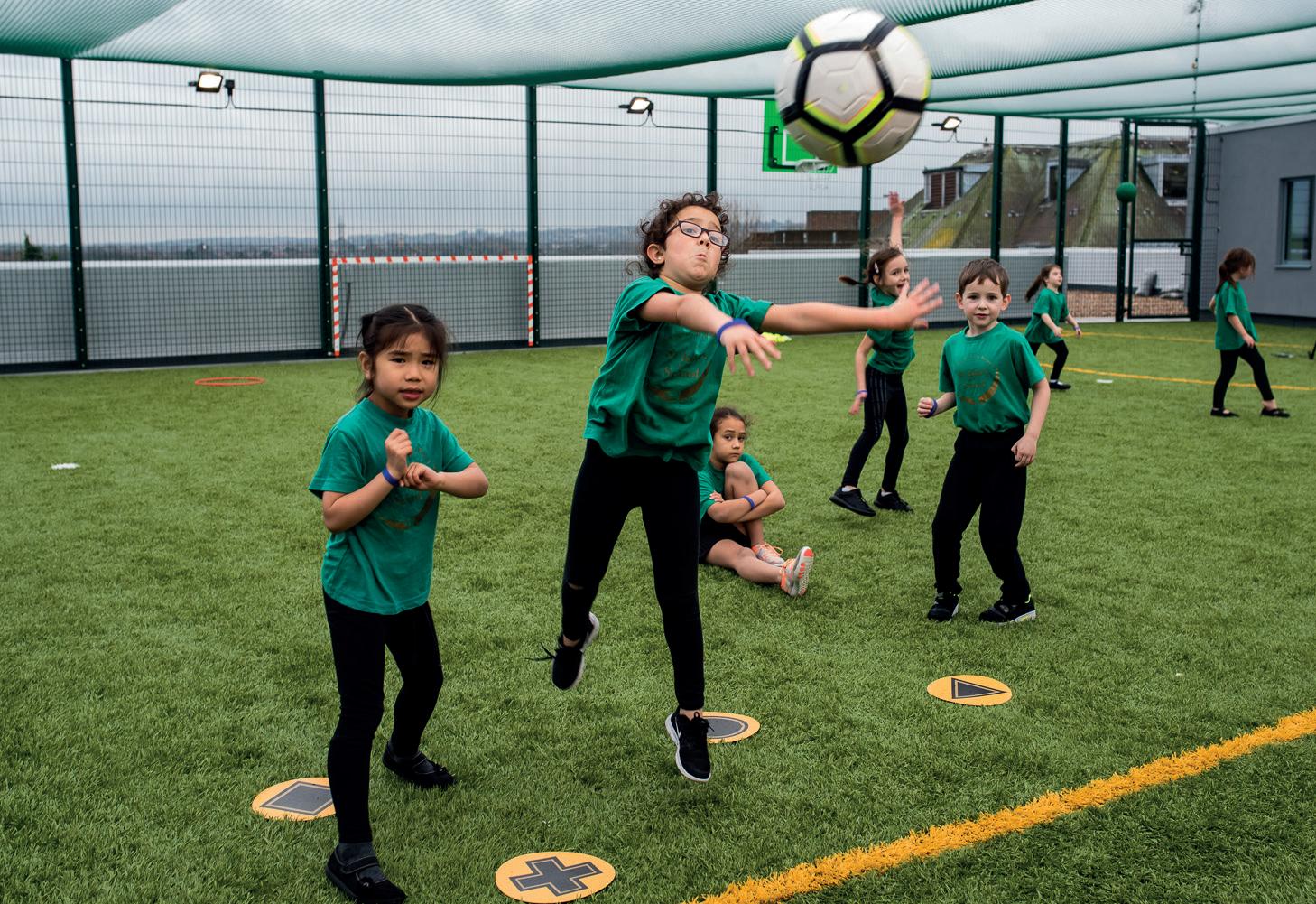

Having joined Activity Alliance as chief executive, I truly believe we are one of the most important organisations in sport, when you consider the challenging landscape will all face in sport and leisure. Collectively, Activity Alliance, the seven national disability sports prganisations, disability charities, Sport England and others were making a real impact before the COVID-19 pandemic. There were significant statistical changes across activity levels in a way that there hadn’t been before.
Through no fault of their own, people don’t have access to sport and physical activity –but we can change that. We have the ability to get rid of some of the unfairness that exists in the wider systems. Our vision is clear and we will work tirelessly to achieve fairness for disabled people in sport and activity.
In a cost-of-living crisis, we know it’s more important than ever to step up and work with others to change, address and evolve the way sport and physical activity is offered. We know there are set to be major challenges that sports and physical activity providers face in 2023 – and Activity Alliance joined

other sport and recreation organisations in urging the government to act now to protect community activity from a looming disaster due to spiralling energy costs. It is our role to play a key part in these


“OUR VISION IS CLEAR AND WE WILL WORK, DAY IN DAY OUT, TO ACHIEVE FAIRNESS FOR DISABLED PEOPLE IN SPORT AND ACTIVITY”
ROCKLYN.CO.UK
Cost effective alternative to traditional building with low running costs.




Year round use of facilities
Can be de ated and removed on a seasonal basis
Remotely monitored & controlled environment

Highly exible – can be installed over existing facilities
Short build time, cost effective, fully exible, permanent building solutions

Low maintenance and long life
Highly translucent fabrics allow the use of natural light


Save on lighting and reduce energy costs


Options include retractable sidewalls ROCKLYN.CO.UK
 Colin Glen Air Dome, Belfast Ellesmere College, Shropshire
Colin Glen Air Dome, Belfast Ellesmere College, Shropshire
It’s a privilege to be appointed chair of SAPCA, having been an active member of the association for a number of years – during which I’ve been a member of the board, the technical committee and a number of working groups.

I take on the role from Jason Douglass, who stepped down at the end of his two-year tenure in December 2022. I would like to take this opportunity to thank Jason for his time, enthusiasm and dedication to SAPCA, both in his role as chair and also as a board member.
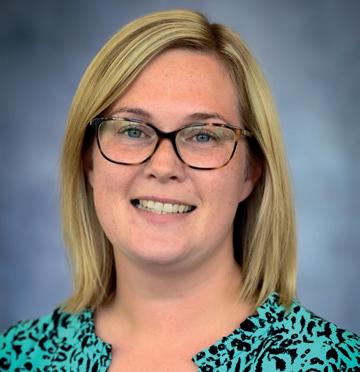
Jason set out a strategy for the future of SAPCA with a clear sense of purpose and direction. Jason highlighted that change was ahead of us and, while this would lead to challenges to overcome, it was also an opportunity-laden period.
SAPCA also welcomed Richard Shaw to the team last summer, as chief executive. A big change for the association and its staff, board and members. Rich has taken the challenge head on and has an active SAPCA workforce and board, committed to delivering on the strategy laid out by Jason, while also addressing matters of interest to our members.
The SAPCA strategy operates under four pillars of identity and focus; to continue to become more business-like in its activities; to place its members central to its focus; to continue to grow a culture of strength in community; and to be a brand recognised for quality and trustworthiness. Through SAPCA events, initiatives and working groups we are bringing topics of interest to the forefront, providing education, guidance, and support alongside SAPCA everyday activities.
SAPCA members operate in an exciting and rewarding industry. The work they do is important, providing high quality, accessible and welcoming play, exercise and sports facilities to individuals and communities that need them the most.


SAPCA members have risen to challenges and have shown that they can work collaboratively to find solutions and achieve common goals. As an association, SAPCA will continue to maintain and improve quality in the industry, provide guidance and education, represent its members on industry matters with sports governing bodies, government departments, standard committees and international partners, and above all provide value to its members.
I hope as incoming chair to continue to drive SAPCA’s strategy moving forward and embrace both the challenges and opportunities ahead of us as an industry. ●
“SAPCA MEMBERS OPERATE IN AN EXCITING AND REWARDING INDUSTRY – THE WORK THEY DO PROVIDES HIGH-QUALITY, ACCESSIBLE PLAY, EXERCISE AND SPORTS FACILITIES”
Why use a SAPCA member?
Planning to develop a sports or play facility?
Make sure the companies you work with are SAPCA members!
There are a number of reasons why you should choose a SAPCA member for your project

• Members must meet strict membership criteria
• All SAPCA members are vetted and approved by SAPCA
• Members are committed to the SAPCA Code of Professional Conduct
• Members must also comply with the various SAPCA Codes of Practice (industry standards for design and construction of all types of sports facilities)
• Members have proven extensive expertise and experience in their fields of work
The “SAPCA Member” badge is a stamp of approval –always look out for it when planning a sports or play project
This year’s SAPCA Conference – the sport and play construction sector’s main event of the year – took place on 13 February 2023 at St George’s Park. The event features a wide range of high-profile speakers and a diverse educational programme, as well as a number of networking opportunities

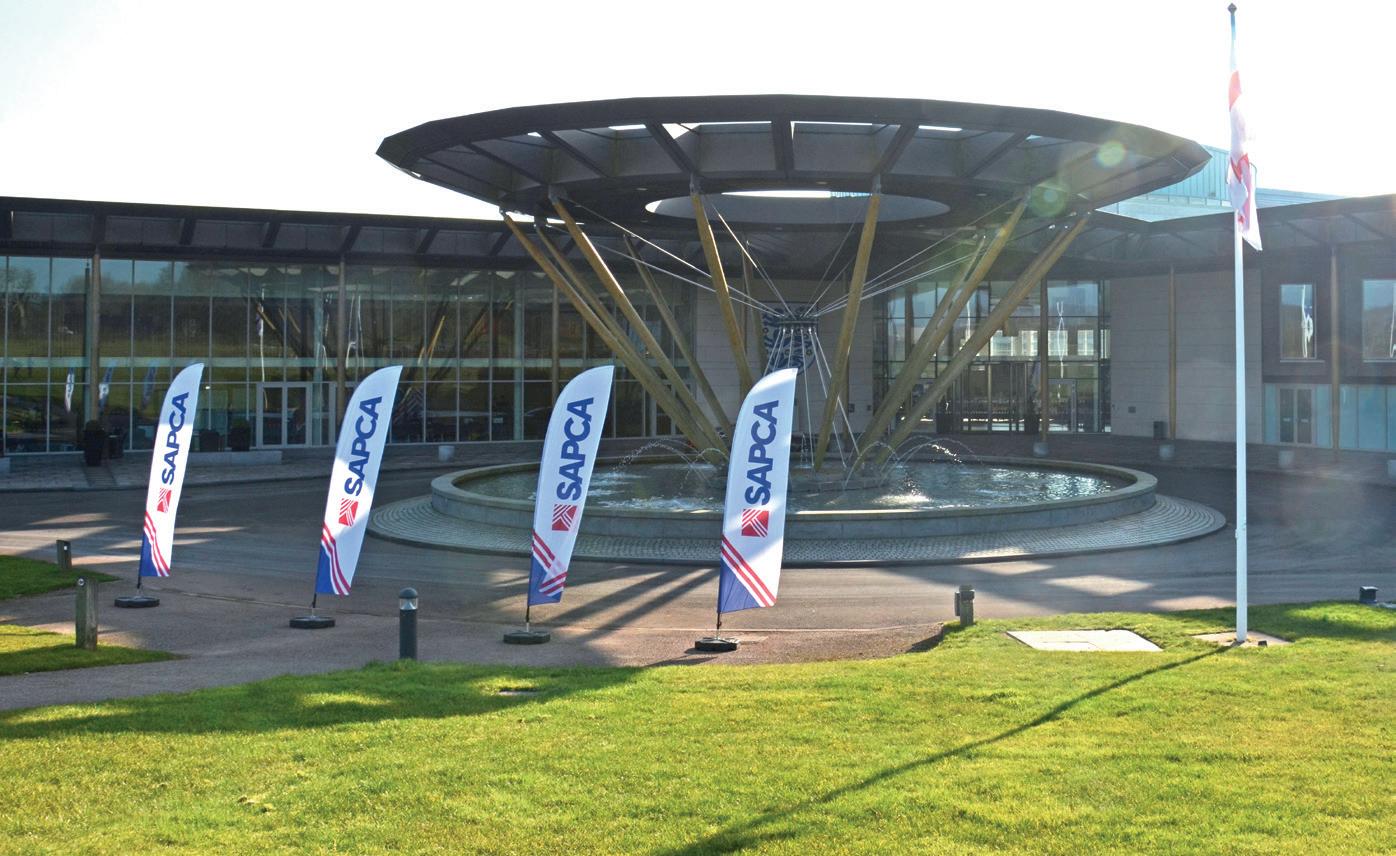
This year’s SAPA Conference kicked off with a passionate keynote speech by ex-footballer and mental health and diversity campaigner, Clarke Carlisle. In a candid and moving speech, Carlisle shared his own journey of mental health and challenged delegates to “have a look around” their own organisations and offered advice on how
to detect the signs of people struggling.
He also offered his views on making workplaces more representative and equal – with specific advice for companies in the sports and play construction sector.
"When a sector is constituted with SMEs and their employee numbers are too small to be able to be truly representative, I would advise that they collaborate to create a group that can oversee and advise the collective,” Carlisle said.
“In the case of your sector, perhaps SAPCA could establish an over-arching Inclusion Advisory Group. A group which could be six to eight strong and representative – but one which also has relevant sector experience.
“This group could then act as the point of contact and advice for all of the

organisations within the sector, helping with issues around equality, diversity and inclusion (EDI) and signposting to further resources/support when the need arises. This way you know that there is a uniform approach across the sector and all good/ best practice can be shared within."


During the day, delegates also heard from Sports and Recreation Alliance (SRA) CEO, Lisa Wainwright, who provided an update on the organisation's work. She highlighted the SRA’s work on Sport England’s diversity and inclusion action plans (DIAPs) and the continuing efforts to help grassroots sports organisations assess the impact – and tackle the effects – of the cost of living crisis.

On the latter, Wainwright said that community sport and recreation clubs are under severe financial pressure and are struggling to cope with the dual impact of steeply rising energy costs and the recovery from COVID-19.
“Rising energy costs and the wider cost of living crisis is putting at risk the long-term sustainability of clubs across the country,” she said.

“In many cases, it is likely they will need to pass on the additional costs to members and users at a time they can least afford it. Therefore, it is no surprise that we are seeing a widening of the gap
between those who can and can’t afford access to sports and physical activity.”
She also cited recent SRA research, which paints a worrying picture of the threats to sporting opportunities.
“The total amount of activity offered by clubs fell by 16 per cent last year, in comparison with 2019 (the last year before the pandemic) – this is a much greater fall than was predicted,” Wainwright said.
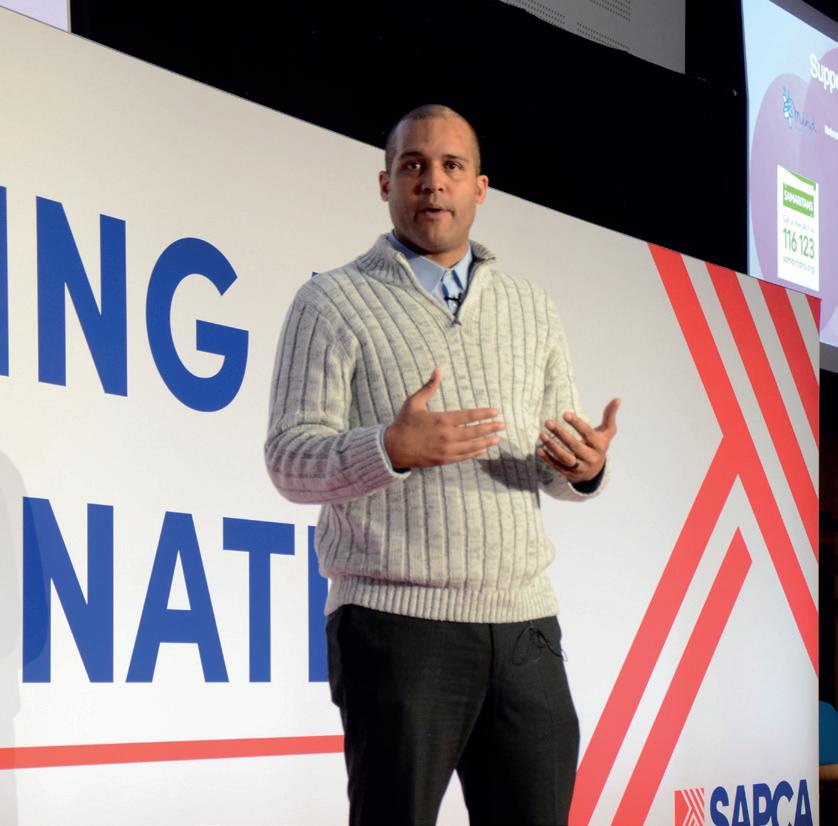
To help grassroots community clubs and facilities tackle the crisis, Wainwright called for more targeted support to help with rising energy costs – including the extension of support via the Energy Bill Relief Scheme (EBRS) beyond March 2023.”




Other sessions at this year’s conference included an update on the current and future legislation regarding the recycling of artificial turf, presented by Phil Conran OBE from 360 Environmental.



Conran – who received his OBE for services to recycling – reminded delegates that whenever a synthetic turf surface reaches the end of its service life it must be classified as a waste. ”Any materials separated from the surface are also classified as waste until they have been fully recovered and are suitable for reuse”, Conran said.
There were also insightful presentations regarding the latest facility funding plans for football and tennis, given by Dean Potter, Grant Funding Manager at Football Foundation; and Karen Shepley, Facility Funding Manager at The LTA. Potter provided an update on the innovative PlayZones Programme, which aims to create multi-sport areas that engage with local communities across the country.
“Our aim is to create sports and activity spaces, which tackle inequalities
in participation, in the areas that need most help,” Potter said.
“Community Engagement is at the heart of this programme and facilities will be designed in partnership with local communities.” ● To find out more about SAPCA and its work, visit: sapca.org.uk/about





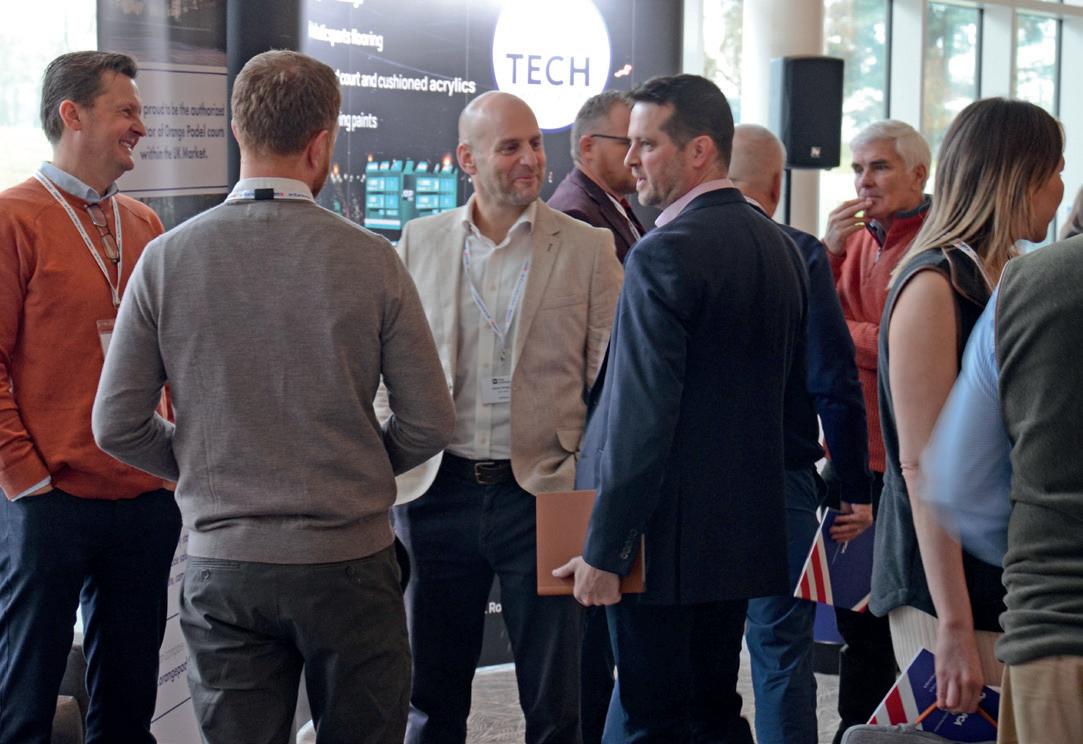
Our aim is to create sports and activity spaces, which tackle inequalities in participation, in the areas that need most help
Dean Potter, Football FoundationMore than 150 delegates attended this year’s SAPCA Conference Clarke Carlisle with members of the Juta Grass team The exhibition floor included a number of SAPCA members Networking is a big part of the SAPCA Conference Dean Potter from the Football Foundation


Now in their eighth year, the annual SAPCA awards celebrate the achievements of members of the Sports and Play Construction Association (SAPCA). Among this year’s winners were a first of its kind recycling facility and an innovative new product set to transform tennis training
The winners of this year’s SAPCA Awards were revealed in February during a ceremony held as part of the SAPCA Conference and Annual Dinner at St George’s Park. The winning entries in six categories were chosen by a panel of judges from a short list of 10 finalists. In total, the SAPCA Awards 2023 attracted more than 30 entries from across the SAPCA membership.
Colin Corline, SAPCA Project Manager and a member of the awards judging panel, said: “The overall quality of entries for this year’s awards was very high. It was no easy task to pick the six winners, which is testament to the expertise, innovation and knowledge represented within our membership.”
Richard Shaw, SAPCA CEO, said the awards showcase the breadth of knowledge and experience within the association’s
membership. “For eight years now, the annual SAPCA Awards have highlighted, to a wider audience, how the association’s members create innovative solutions, deliver complex projects and pioneer industryleading products and services,” Shaw said.



“SAPCA represents the best of the industry, so these awards showcase the best of the best – which means that the winners should be very proud of their work.
“This year’s cohort of winners is no exception and shows how SAPCA members lead the way when it comes to innovation and excellence within sports and play construction. It was especially heartening to see so much strength around sustainability, which shows how the industry is leading from the front when it comes to tackling the environmental challenges that the world faces.”
The HS2 rail project forced Old Saltleians RFC – based in Water Orton – to look for a new permanent home. O’Brien Contractors answered the call and, by using its in-house civil engineering & building construction expertise, delivered a turnkey design and build solution.

In total, O’Brien developed 17 acres of former farmland into a sports facility with six natural turf pitches, a clubhouse and associated infrastructure. The project has provided the club and the rugby community with a state of the art facility that provides the facility for the club to grow and will stand the test of time.

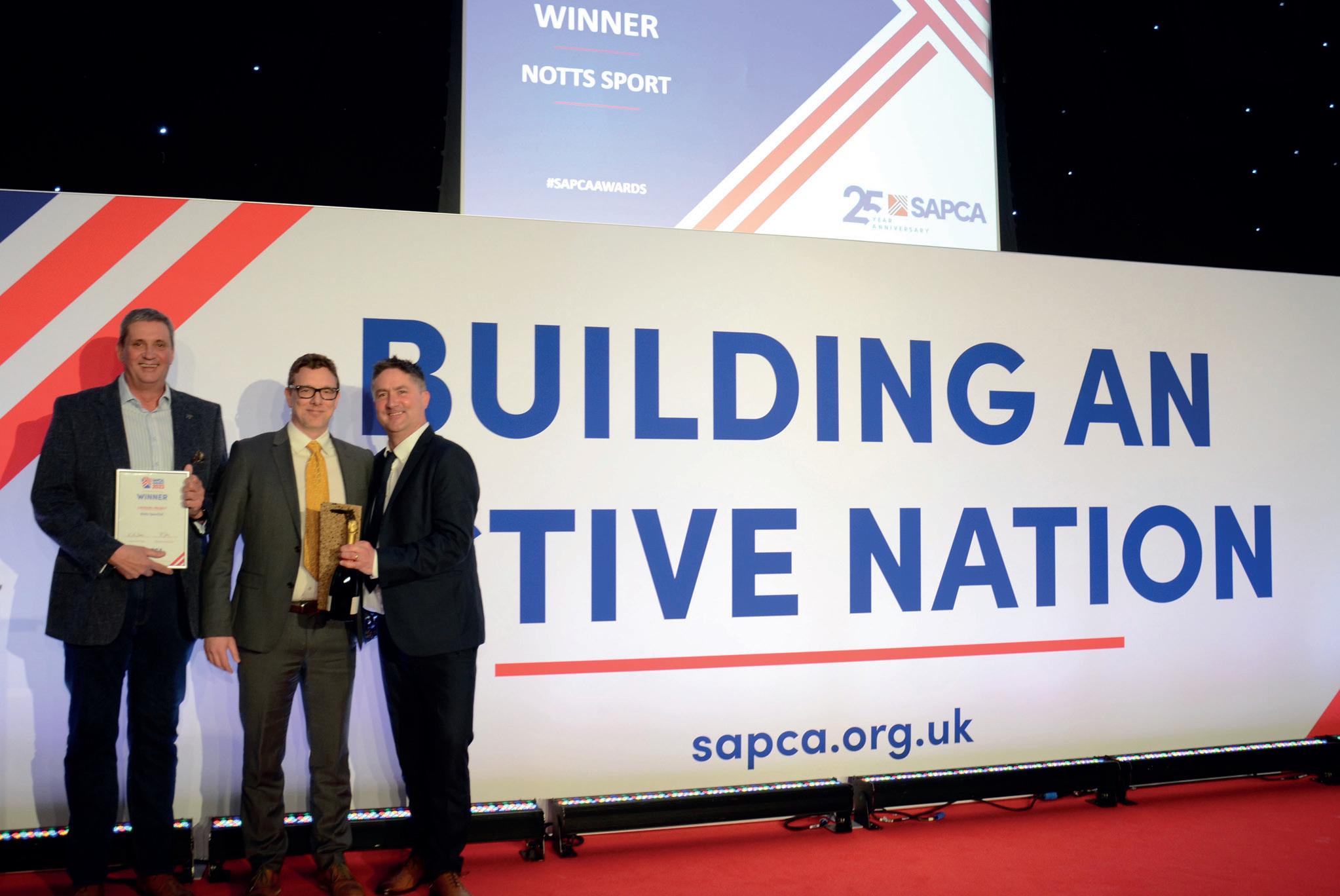
Notts Sport helped transform an underused and decrepit macadam area at Shooters Hill Sixth Form College, London, into two sustainable, non-infill football pitches – the first installation of its type in the UK. The unique solution consists of hard-wearing but soft pile in two shapes combined with a voluminous air texturised thatch layer replacing the performance infill.
The facility houses two small-sided football pitches located within the original footprint, maximising the versatility and commerciality of the available area. The college now has the opportunity to hire the unique pitches out to local clubs and the community, creating a sustainable solution both in terms of design and through a long-term business plan.
Andrew Earnshaw (left) and Duncan Bennett (middle) The O’Brien Contractors team on stage
Clearplay is a new, game-changing practice wall for tennis which can be installed retrospectively within existing tennis courts, or as part of new projects.

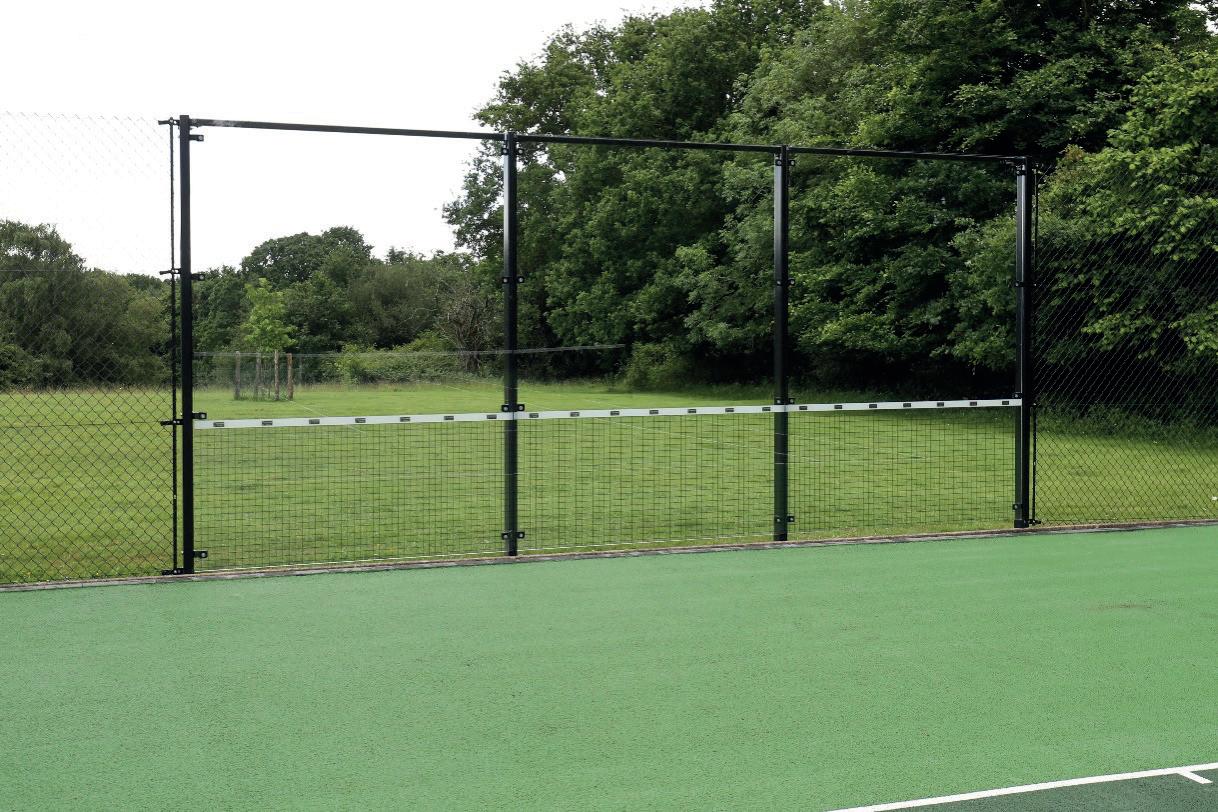
Clearplay walls have been designed to help tennis players to warm up, practise hitting and improve their technique ahead of matches. Imprinted on the back of the Clearplay glass are net markings, to replicate the height and appearance of a tennis net. This gives players the opportunity to aim shots just above the net, practising and perfecting their forehand, backhand and volleys. The modular design means facility operators and owners can add one or more Clearplay walls.


Sportex developed and opened the UK’s first 100% closed-loop recycling facility for end-of-life synthetic turf sports fields. The custom-made technology used at the facility ensures that all components and materials from old synthetic turf pitches – that would otherwise have ended up in landfill – can be separated, thoroughly cleaned and offered a new life.
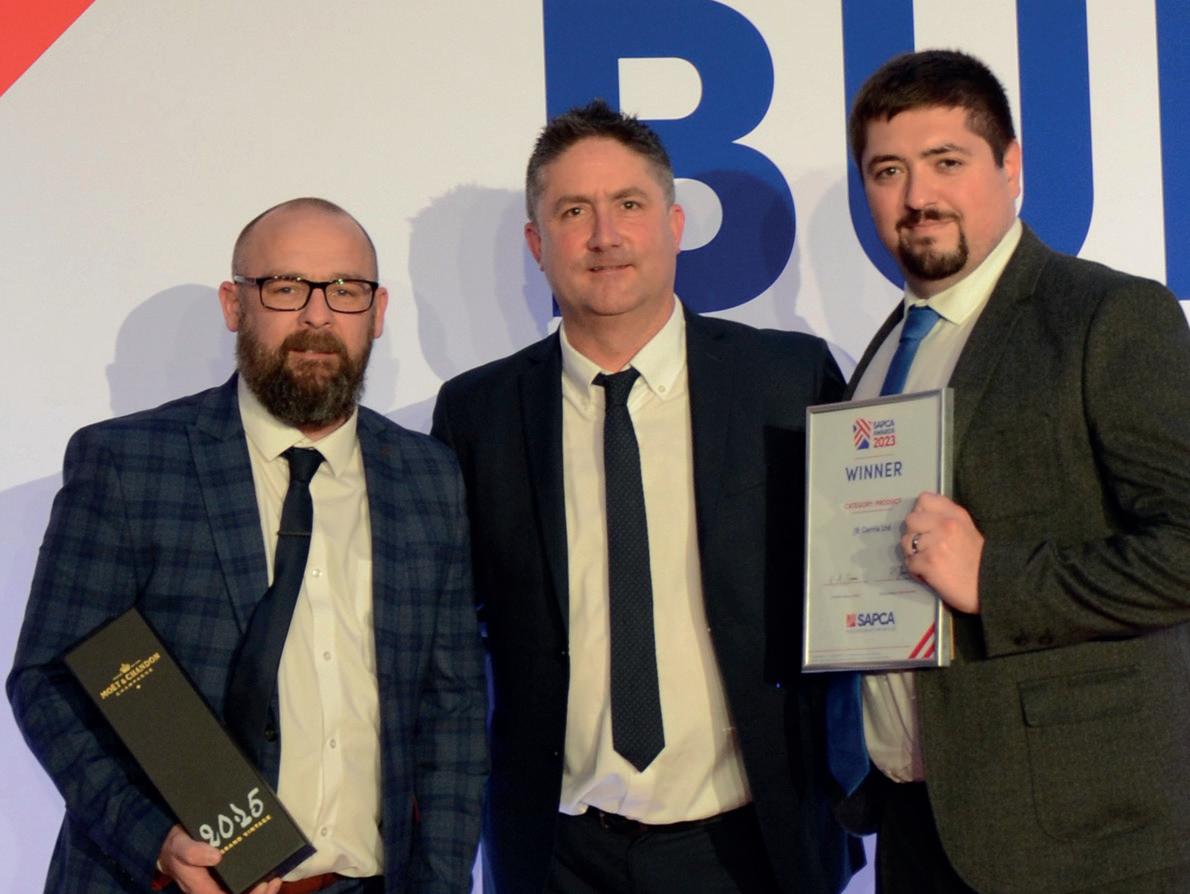
The plant can process up to 500,000sq m of old, used artificial turf of any type, in any condition, each year – potentially eliminating 12,500 tonnes of classified waste from entering landfill. This translates as a potential saving of more than 1,321,500kg of greenhouse gas emissions.


Despite Brexit-induced customs and logistical challenges, 2022 was a record sales year for Surftech’s export arm. The company achieved bumper sales from existing partners in Germany, Netherlands, Belgium, Hungary, Czech Republic and Poland. These were in addition to Surftech’s activities in Hong Kong and the commencement of trading with new partners in Switzerland, Barbados and Slovenia. Surftech’s export range of products includes acrylic tennis courts, point elastic sports flooring and specialist line marking systems, with these trading under the brand Proflex.



The new Aqua-Fix is a single component, high strength, moisture curing adhesive specifically formulated for the bonding of artificial grass. What makes it innovative is that it enables carpet seam bonds to be made even if the presence of water is excessive.
This means that it is tolerant of adverse weather conditions and environmental influences – making it ideal for the UK climate.






We are living in a VUCA world (volatility, uncertainty, complexity and ambiguity) – constant unpredictable change that is now the norm
Jo Cherrett
Trafford Leisure, a community interest company, was established in September 2015 to provide leisure services and recreational activities at the major Trafford Council facilities. With a vision to make Trafford the “most active place in England”, it is a non-profit organisation, wholly owned by Trafford Council.

SportsNation spoke to Jo Cherrett, Trafford Leisure’s CEO, about the company’s plans and the challenges and opportunities faced by public leisure operators.
How did you progress to the role of CEO at Tra ord Leisure?
I started out by spending 13 years with First Leisure – one of the first Investors in People organisations in the early 1990s. I worked across the UK in family entertainment, 10-pin bowling, bars and nightclubs.
My transition into public sector/leisure centres was genuinely only meant to be for six months, but that quickly led to a regional manager role at Clear Channel Leisure, running Halton, Peak District and Trafford leisure centres. When a charitable trust was set up in Trafford, an opportunity arose to come and join the new CEO and support him. I was a director with Trafford Council Leisure Trust and then became CEO in October 2015 when its Charitable Interest Company status was created.
You’ve been CEO since 2015 – what has been your greatest achievement so far?
I’m extremely proud of Trafford Leisure’s new brand, move. From the initial strategy and developing a human brand, to bringing the brand to life in our facilities – through the rebranding and redevelopment of facilities – it has been a real privilege and achievement.
When we say move is a “human brand”, we mean that it is one that naturally evolves and changes – and one that doesn’t present itself as being perfect and air brushed, but one that connects with its community.
I’m also proud of Trafford Leisure’s Sustainable Development Goals (SDG), the blueprint to achieve a better and more sustainable future for all – from the environment to those in the Trafford community who need the most support to become active. As the community benefit programme evolves further, the SDGs will be embedded further into a more customer-focused brand.
We’ve achieved great things so far, such as helping fund swimming lessons for all Year Three primary school children in the area, working together with Manchester United FC to fund swimming for children with highly complex disabilities and providing children who live in care with a free activity package.
We’ve also provided Trafford’s returning armed forces service personnel with free, one-year Move Well memberships and set up an Active Trafford concessionary scheme and physical activity referral programme to support those who may need some financial support, alongside those who want to take the first step to become active.
What are the biggest challenges you face as CEO today, in the current climate?
Our depleted workforce is having an impact on our business. We are living in a VUCA world (volatility, uncertainty, complexity and ambiguity) – constant unpredictable change that is now the norm. It demands that, as CEO, you avoid traditional, outdated approaches to management and leadership and day-to-day working. For example, the pandemic has fasttracked how people approach where they work, how they work and what their employment
expectations are. People are re-evaluating what’s important in their lives, and staff are reflecting on how they worked differently during the pandemic, with the key takeaway that flexible working is here to stay, it’s not a fad.

On a positive note, if you embrace a flexible workforce there is no reason that you couldn’t have someone working for you based anywhere in the world. This should give us more opportunity to find the right, innovative people for the sector.
The challenge for leisure, as well as hospitality, is that there are two trends in place. Our senior managers and support staff are largely working in a hybrid model, whereas our operational and front of house staff are not – as they obviously need to be on-site.
I’m working hard to make this hybrid model of working visible to those who do the shift work too, or else there is a real risk of creating a divided culture, where it is
deemed that one part of the workforce has complete agility and flexibility, but those who are predominately paid less have none.
The increase in utility costs will impact all leisure providers and Trafford Leisure is no different. The volatility of the energy market reaffirms our strategy to become even more sustainable and environmentally-friendly.
Since forming in 2015, Trafford Leisure has reduced its energy consumption year on year through a dynamic energy saving programme, including the introduction of LEDs, combined heat and power, automated sensors, as well as using strategic contractors to review utility data and make changes quarterly/seasonally.


The refurbishment designs also include the replacement of the fossil fuel (gas) heating system with air-sourced heat pumps and solar panels, which are significantly more sustainable options and support Trafford Council’s carbon neutral action plan.
We’re also committed to making our facilities as sustainable as possible and have pledged to cut our carbon emissions 5%, year on year, until we operate at carbon neutral by 2030. We partnered with Planet Mark this year to measure our carbon footprint and committed to being accredited each year. This means that we need to achieve the 5% reduction year on year in order to remain accredited.
Our move Urmston centre was praised by RIBA for its commitment to public health,

We’re also committed to making our facilities as sustainable as possible and have pledged to cut our carbon emissions 5%, year on year, until we operate at carbon neutral by 2030
as well as ensuring the centre was greener, more efficient and had taken the first steps in reducing its carbon footprint. The rebuilding work itself was hailed for its innovative use of natural light and ventilation that saves energy – and keeps users of the leisure centre cool.
LED, salt electrolysis chlorination and micro filtration are just some of the initiatives we are championing to improve health and safety, while also reducing the Co2 footprint. Eight years ago we migrated to a new, totally safe system, which uses water and electricity to turn locally-sourced food grade salt from Cheshire into a chlorine-type solution called sodium-hypochlorite, which is automatically drip-fed into the pool depending on the level required. The solution is below the threshold for classification as a hazardous substance, so it instantly slashed our health and safety risk and reduced our daily maintenance costs.
Trafford Leisure also has new Danish water filter technology. The majority of public swimming pools in the UK still use traditional sand-filters and, in January last year, Stretford Leisure Centre was England’s
only mainstream commercial pool to install micro filtration, where water is cleaned by being pushed, under pressure, through porous ceramic material. In fact, the system was so new that Sport England is using Stretford to run a study into its efficiency.

However, I also see the big challenges which the leisure sector faces as fantastic opportunities. Because leisure is changing.
We no longer want people to associate public leisure facilities with dark, badly lit sports halls, staffed by duty managers, fitness instructors and swimming teachers. We want to pivot and overhaul this model – and to truly embrace wellbeing.
This pivot can be achieved through a high level design concept, with a broad facility mix, with collaborative business and community links. What we will see in the future are wellness hubs that incorporate GPs, rehab specialists, community outreach programmes, mental health experts, health referrals, healthy eating hubs – as well as studios, swimming pools, hydrotherapy and drop in MOT health checks. Leisure will transition to become wellness

and doing so will support efforts to reduce inequalities and to promote overall wellbeing.
How many (and what types of) facilities does Tra ord Leisure manage?
We’re the largest operator of sport and leisure facilities in Trafford, with eight indoor facilities, one golf course and driving range and 31 outdoor football pitches. Our venues attract more than 1.5 million visits and employ a workforce of over 300. Each week we help more than 9,000 children learn to swim.
What facility projects are you planning?

We have massive plans for multi-million pound refurbishments of our Altrincham, Sale and Stretford Leisure Centres. We’ve also just been awarded £18m in Levelling Up Cash to redevelop Partington Sports Village. The plans there include a comprehensive refurbishment; improvements to the BMX pump track and associated facilities for public usage; a full renovation of changing rooms at Cross Lane Park; and the introduction of a Trim Trail and Public Realm – a path around the park to enhance access and support walking and running in the area.
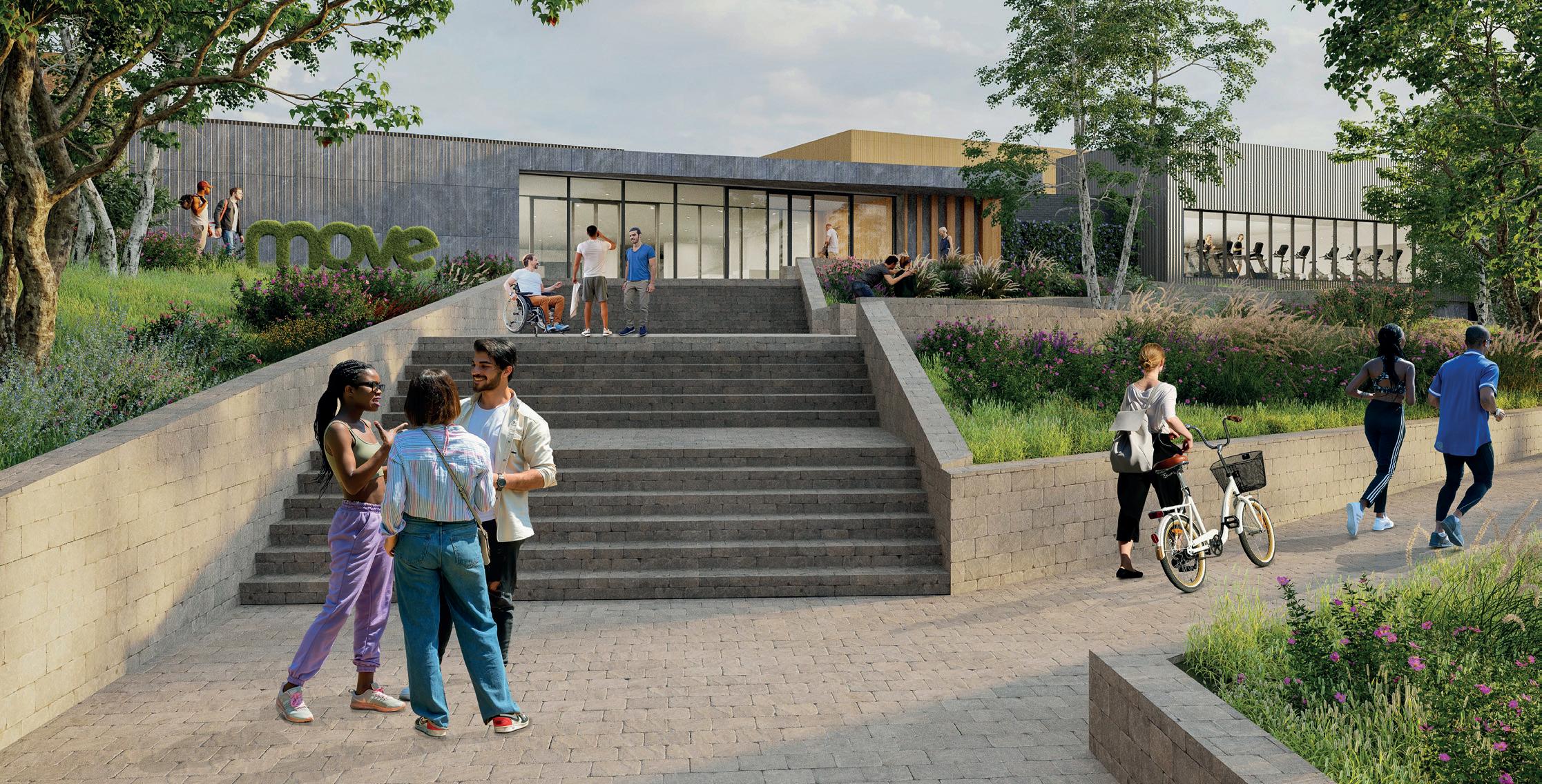
The huge investment in the leisure centres supports the council’s physical activity strategy, ‘Trafford Moving’, which is a commitment to get people moving more often to help improve health and wellbeing and reduce inequalities. It forms part of a borough-wide long-term strategy to support the health and wellbeing of local residents through access to affordable, sustainable, accessible and exciting, modern leisure facilities.
What are the biggest challenges that councils like Tra ord face, when it comes to improving facility stock?
Finances always come into it. Leisure isn’t a statutory service, so local authorities have to make difficult decisions about what they can do and what they can afford, balancing with knowing that investing in sport and physical activity will improve health and wellbeing outcomes of residents.
For us, that means operators and the local authority work closely together to make sure that as much of the investment as possible currently going in to indoor leisure can be repaid and sustained over a period of time. Not easy in VUCA times.
How would you improve the way sports facilities are built and managed?
It has to be on sustainability and carbon reduction. Over recent years, governments have come to realise that changes have to be made if the situation is to improve.
There are more than 2,500 leisure centres in the UK, all with a large carbon footprint. All are battling with the need to change alongside outdated policies and legislation on accessibility and sustainability.
The funding through Public Sector Decarbonisation Scheme is great, but how much more could be achieved with dedicated resources from experienced, ‘outside the sector’ experts on technology and engineering? They could turn the cost lines currently experienced in leisure centres, into revenue lines. It needs innovative thinking backed up with legislation to drive through change. ●
STAND OUT FROM THE CROWD
WITH 25 MILLION PLAYERS WORLDWIDE, PADEL TENNIS HAS QUICKLY BECOME THE UK’S FASTEST GROWING SPORT
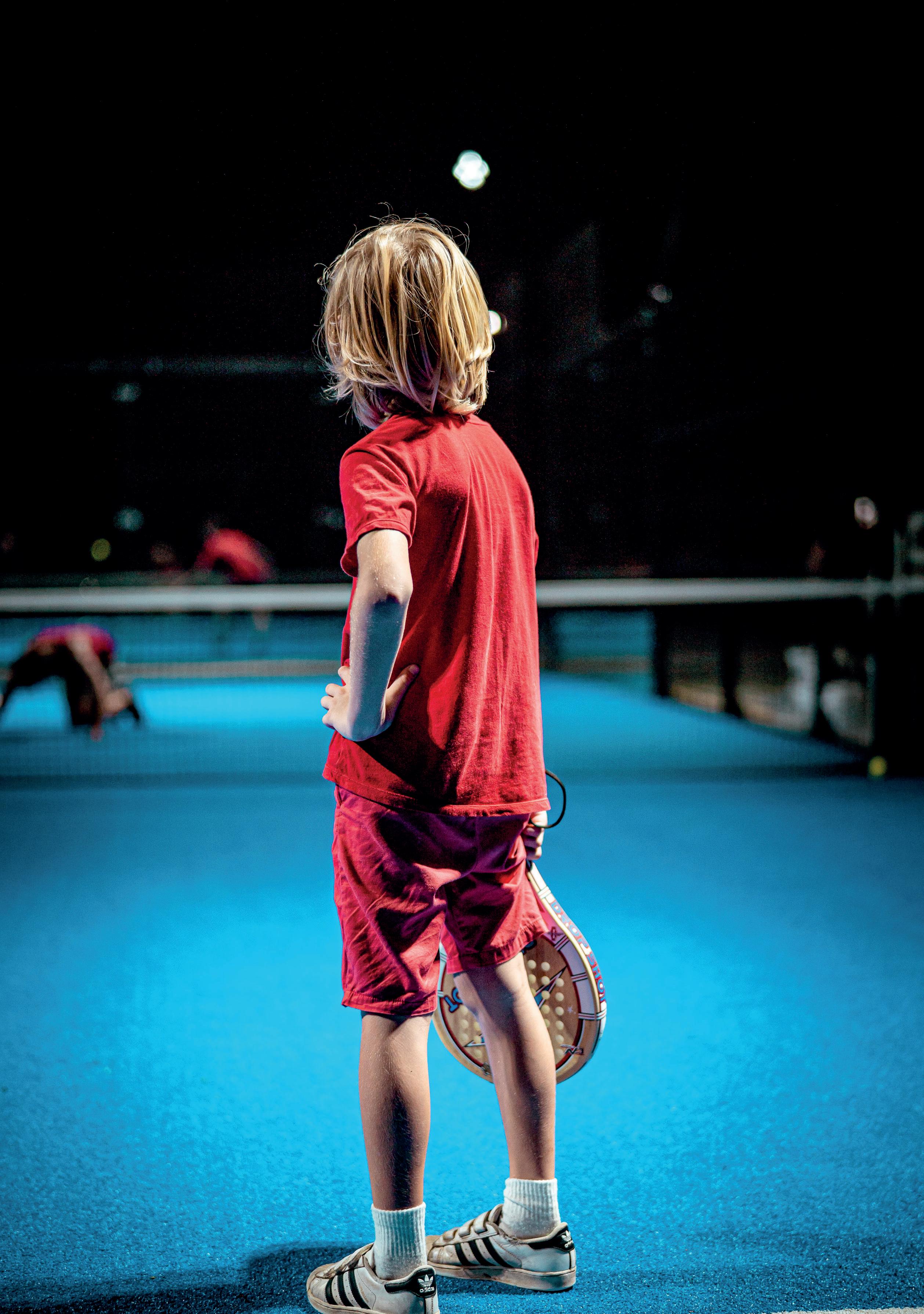
TRUST S&C SLATTER WITH YOUR PROFESSIONAL PADEL COURT INSTALLATIONS

T: 01635 34521 E: info@sandcslatter.com




Padel has been rapidly expanding across Europe for the past decade. Since its “invention” in Mexico in the late 1960s, the sport first conquered Latin America, before becoming hugely popular in Spain in the 1980s and 1990s. From there, it has gained a foothold around the continent and is now hugely popular from Italy and Portugal to Sweden and Finland. In Europe, the growth in the number of padel facilities and players has been particularly strong throughout the 2010s. Italy, for example, has seen the number of courts explode from less than 100 in 2014 to an estimated 3,500 in 2022. In northern Europe, where the climate dictates that most courts are built indoors, the growth has been rapid too – showing that the

A hybrid of tennis and squash, Padel is played by millions across the globe. Its popularity has grown rapidly in the UK in recent years, with courts popping up all around the country
popularity isn’t purely down to outdoor facilities. The number of courts in Sweden has increased at a similar rate to Italy. Finland too is currently in the midst of a padel boom, with the number of courts increasing sixfold, to 500+, since 2019
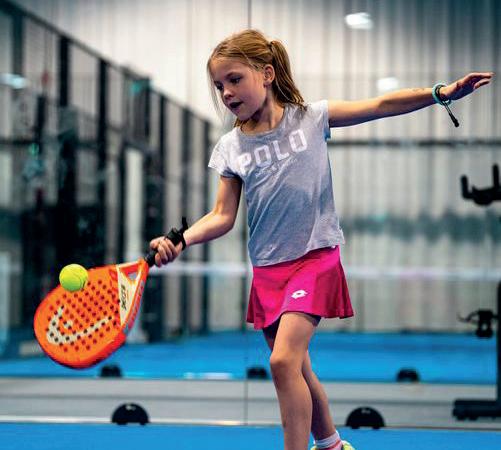
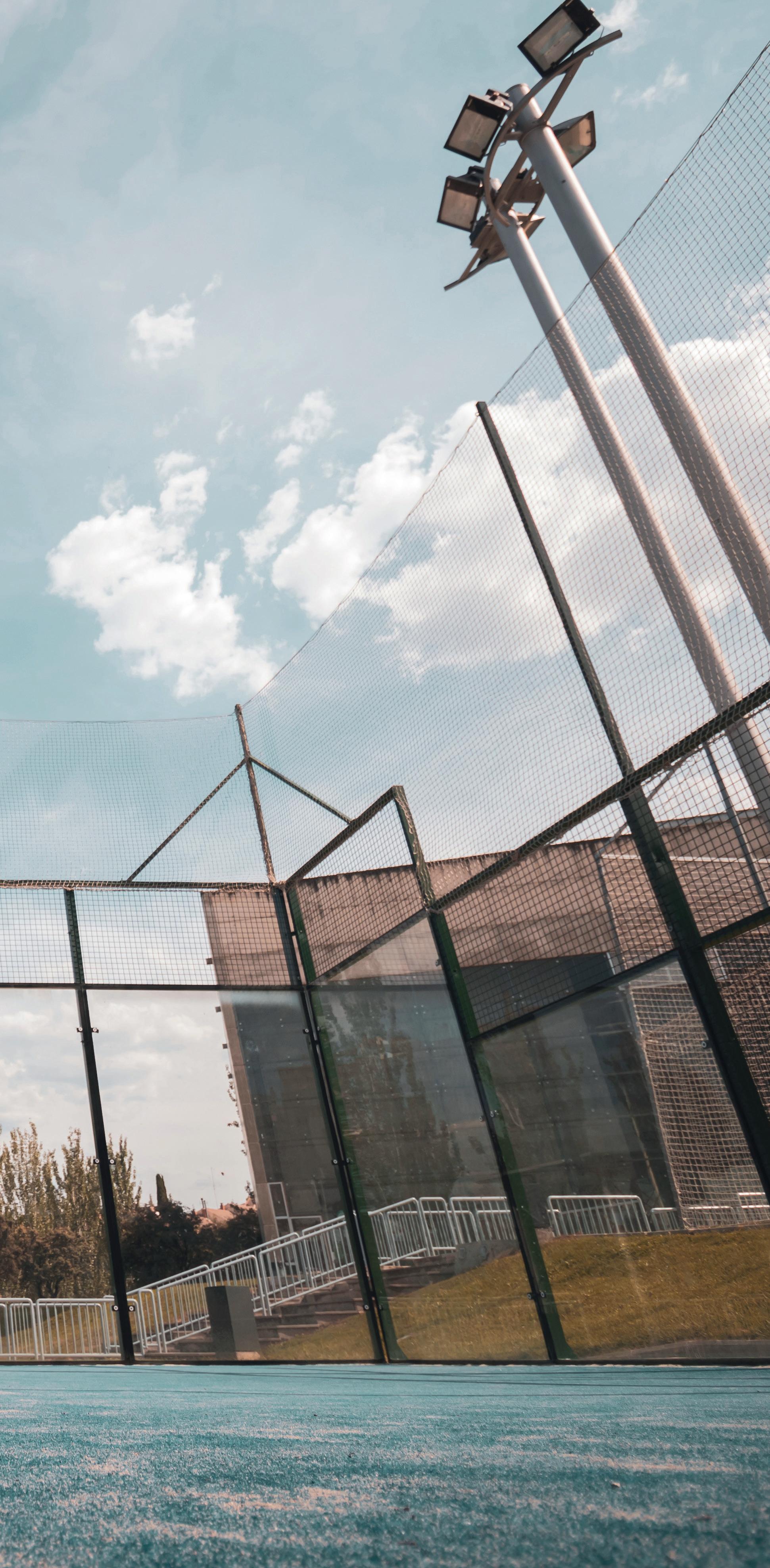
Padel’s popularity is down to its accessibility – it is easy to pick up, doesn’t require previous racket skills, so families can play together as well as players of all ages and abilities. It’s very social, no dress code, the only equipment players need is a padel racket and a ball – and most venues will offer the equipment to hire. Played on an enclosed court about one third the size of a tennis court, padel’s rules are the same as tennis and it is played with the same balls. Serving is made under-hand and the walls are used as part of the game.
While padel had been played in pockets – and on unofficial or makeshift courts – in the UK throughout the 1990s and 2000s, the first real push to establish the sport here came in the early 2010s. In 2011, racquet and health club operator, David Lloyd Leisure, opened its first purpose-built courts, marking the arrival of commercial courts. That same year, the British Padel Federation was
established, sparking a period of expansion. By 2019, padel had grown to such an extent that the governing body for tennis, the LTA, integrated British Padel into the organisation’s day-to-day operations.
The number of courts has quadrupled since the LTA incorporated padel into its operations and there are currently around 230 courts in Britain, with 89,000 active players. To help grow the number of players, LTA has introduced participation programmes, such as developeding a Padel version of its Tennis Xpress programme, with the view to help introduce people to the sport and provide them with the basics.
The governing body says it plans to grow the sport further, including investment in new courts. “We will continue to roll-out new programmes to support venues,” says the LTA’s head of padel, Tom Murray. “We have always targeted organic and sustainable growth of facilities and anticipate the number of courts to rise to 320 by the end of 2023.”
The governing body published its strategic plan to grow the game in 2019.
Scott Lloyd, LTA Chief Executive, says that the plans to

Padel’s popularity is partly down to its suitability for all ages
Integrating padel into the LTA in 2019 was the first step in what we hope will be a bright future
grow padel will be based on six pillars.
“Integrating padel into the LTA in 2019 was the first step in what we hope will be a bright future,” Lloyd says. “It provided an immediate platform to facilitate the organic growth of the sport, with tennis venues throughout Great Britain already exploring the potential opportunities it can bring to a facility.
“Our development plan identifies six growth enablers. These are the essential ingredients that, collectively, will ensure padel is able to scale up.”
The six pillars are:
1. Places – increasing the number of courts
2. People – building a coach and activator workforce
3. Programmes – making it easy to learn how to play the sport
4. Pathway – providing the environment to help players reach their potential
5. Partnerships – working with partners to accelerate growth


6. Promotion – raising the visibility of the sport to attract players & fans
The LTA’s focus to date has been on laying the foundations and infrastructure of padel as a sport in Britain through facility development, increasing the number of courts, developing a coaching workforce and working with other partners to maximise the potential of the game. Courts are being built mainly in tennis clubs, schools, universities, parks, leisure centres and community indoor centres. There is, however, a growing number of commercial operators investing in padel and padel facilities.
Murray adds: “We want to ensure the game continues to grow sustainably over the next few years in line with increasing demand and interest and will also continue to identify how we facilitate the growth of the private sector as a great opportunity to expand the reach of the sport.“
To help grow the number of courts, the LTA operates a quick access loan scheme and applications are welcomed for both outdoor and covered padel courts. The fund will cover up to 60% of a project cost with a 5-7 or 5-10 year repayment period.
In 2022 the LTA supported the delivery of 18 (12 covered/6 floodlit) padel tennis courts through the quick access loan scheme. This amounted to a total LTA Tennis Foundation investment of £1.3m.
Alongside working with tennis venues, the LTA is working with leisure operators and trusts to build padel tennis into their portfolio of facilities; and engaging NGBs to demonstrate how padel tennis can be delivered as part of a multi-sport offer.
One of the commercial operators making waves in the UK is Surge Padel, which opened the UK’s largest premium indoor centre in Harrogate in January 2022. It followed that by the opening of another centre in Bristol in March 2023. It is currently preparing to open several further sites in 2023 and beyond.
According to CEO Stuart Perrin, the growth of the sport has been phenomenal. “When I started

my discovery of the sport in the UK two years ago there were just 88 courts across the country, today we have more than 200,” Perrin says.
“The demand for courts is extremely high. Our peak courts are being booked out for three weeks in advance in most instances. I think that the padel market will follow a similar growth pattern that we saw in the gym sector in the 1990s, so get ready for a boom in the next two years. Within five years I believe every major town and city will have a club.
“That’s why we have big plans for the UK market – we can see 30+ openings in the next 3-5 years.”

The Surge Padel model is based on large, indoor centres housing multiple courts. As a result, Perrin is looking for particular geographical areas for expansion.
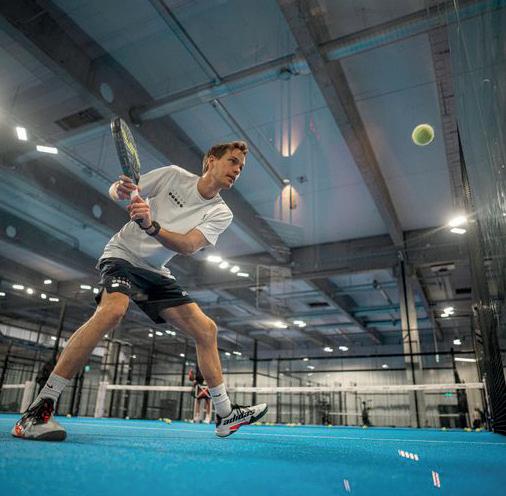
“Lots of our competitors are focusing on smaller outdoor offerings,” he says. “We are 100% indoor and we like to go big. We look for affluent towns/ cities with good transport links to allow those further afield to still experience our clubs.”

I think that the padel market will follow a similar growth pattern that we saw in the gym sector in the 1990s, so get ready for a boom in the next two years
Another operator looking to expand its presence in the UK is LeDap Group, which currently operates more than 150 padel clubs, with almost 1,000 courts, across nine countries. LeDap opened its first UK club in Derby in 2022. Housing 11 indoor padel courts, the club is operated under LeDap’s We Are Padel brand. The other divisions of LeDap Group are Mejor Set, its Spain-based padel court manufacturing arm; the LEDAP Shop, an e-commerce website selling padel equipment; Bookli, an online padel booking platform; and the Swedish Padel Open tournament.
According to Eno Polo, CEO of the LeDap Group, there will be “significant investment” in padel courts, because the demand is way ahead of the current supply.
“There are currently around 230-240 padel courts in the UK which, as it stands, is not enough to fulfil the exponential growth of the sport here,” Polo says. “Back in 2020, there were roughly 20,000 players in the UK. Today, however, it is thought that there are more than 150,000 players nationwide – and the sport just keeps growing. The increasing demand is driving the development of new facilities and we are witnessing new padel clubs opening on a monthly basis across the UK. We’re also seeing several tennis clubs converting their tennis courts into padel courts to meet the demand of people wanting to play the sport.”

Polo adds that, like Surge Padel, LeDap is looking to grow its portfolio of sites rapidly. “We currently have two We Are Padel clubs in the UK - Derby and Bristol - and the plan is
to keep expanding through new facilities all over the country year after year,” Polo says.

“From a court manufacturing perspective, we see the increase of standalone padel clubs, tennis clubs converting some of their space into padel courts, and last but not least, private homes and residencies asking for their own padel court. There’s a really strong mix of opportunities.”
Another padel centre operator, Game4Padel, has five venues in England, three in Scotland and one in Wales. It also recently opened its first site in Australia and is soon opening a seven-court centre in Spain. The company has ambitious growth plans too, with another 15 locations planned for England, three in Scotland and one in Wales.
Backed by tennis star Andy Murray, the company has been valued at £18m in its latest investment round, during which the company raised £3m

In Spain, padel is now the second biggest participation sport after football. Racket sports are popular here in the UK so it is a natural transition for many people to try padel
from retail and institutional investors. “We have a pipeline of sites with planning in place that will be rolled out over the next 12 months across the UK,” says CEO, Michael Gradon.
“We aim to have 30 venues operational at the end of this year and recently signed a partnership with GLL, the largest leisure operator in the UK, which means we will be able to rapidly grow the number of courts.

“We believe the market will be unrecognisable in five years’ time, with thousands of courts and a wide audience for padel. This has been demonstrated all across Europe, where courts have been rapidly built and there is an actively engaged audience that play regularly. In Spain, padel is now the second biggest participation sport after football. Racket sports are popular here in the UK so it is a natural transition for many people to try padel.”
The predictions for rapid growth are mirrored by Steven Armitage, MD of Ream Padel – a partnership between Spain-based padel court manufacturer Jubo Padel and international property development and management company, Ream International.
“We analysed the international marketplace to identify countries with growth potential,” Armitage says. “The UK, together with Germany, came out top in every analysis – whether it was spending power, sports tradition or, most importantly, the scarcity of existing padel facilities. We have now created a business model specifically for the UK, which was launched in January 2023, together with a marketing campaign.”
A number of SAPCA members are involved in the design and build of padel courts in the UK – and also

●
●
●

abroad (for a full list, refer to the SAPCA website’s “find a member” service). One of these is Padel Tech, which has to date built around 120 courts.
According to founder and CEO, Paul Ross, the UK’s padel sector has enormous growth potential. “In Sweden, there are currently 33 padel courts per 100,000 people. In Finland, where the market is relatively new and still growing, the figure is 9. In the UK, there are only 0.2 courts per 100,000. So even if the ‘padel boom’ wouldn’t be as big as it has been elsewhere in similar markets – although nothing suggests it won’t – there is still huge demand ahead.”

He adds that, as demand for padel courts grows, it is important that facilities are built according to high standards, ensuring the continued growth of the sport.
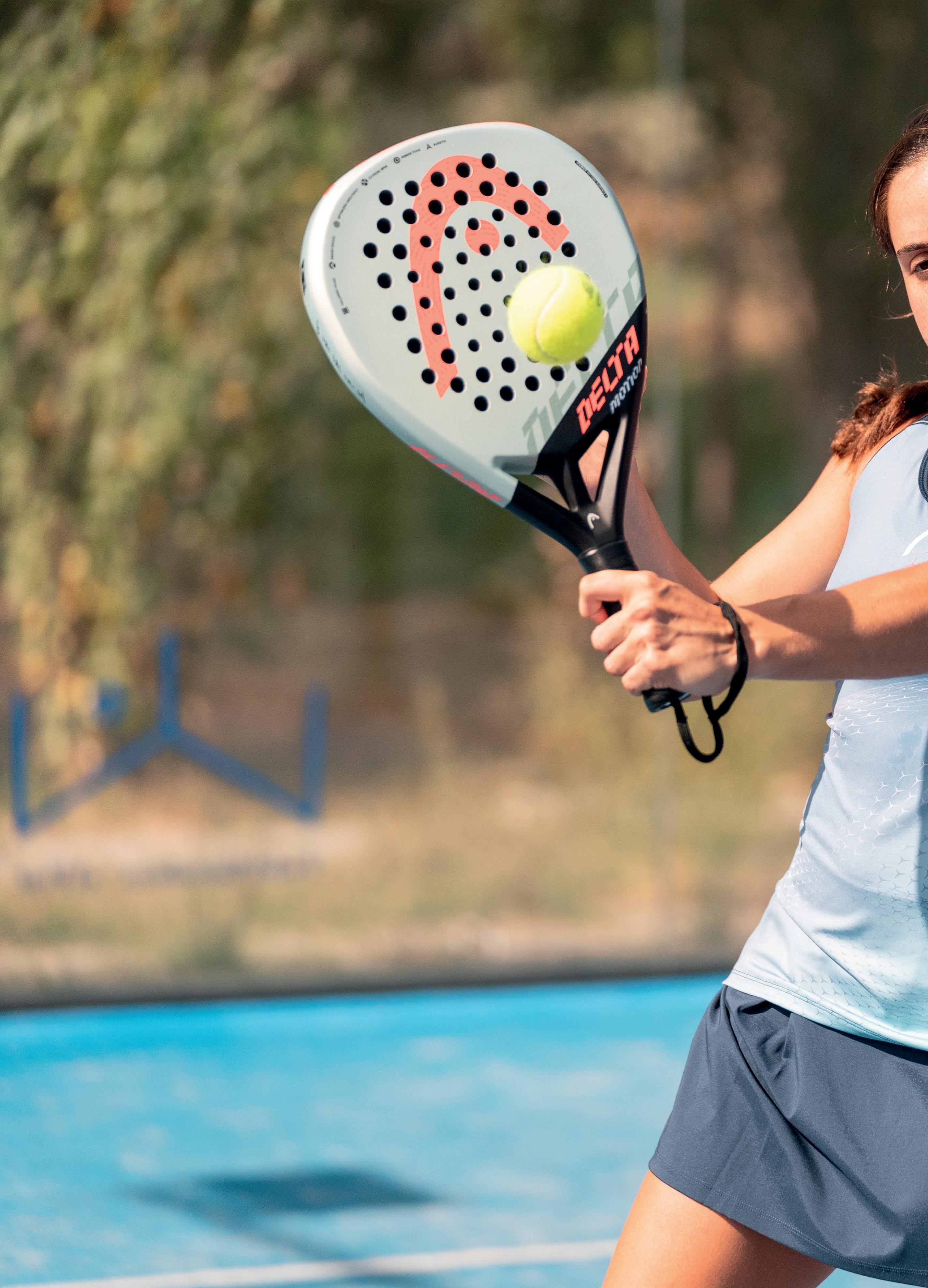
“At the rate that we expect padel to explode – and especially if it follows the likes of Finland, Sweden and Italy – demand is very quickly going to outstrip supply,” Ross says. “In this context, it is in all of our interests within the industry to ensure we are meeting, exceeding and refining standards.”
Another SAPCA member that is active in the UK’s padel space is structures specialist Copri Systems. Rafe Colenso, Director at Copri, says that while outdoor courts are popular, there is a move toward indoor facilities – mainly due to the climate.
“So far, the majority of our projects to date have been for outdoor court construction,” Colenso says. “But we are talking to more and more clubs at the moment about building indoor structures, as the amount of revenue that is lost from cancellations owing to bad weather is significant.
“This winter has been especially bad, with high winds, periods of continuous rain and sub-zero temperatures. Yes, indoor facilities are going to be
more expensive upfront, but the LTA conducted some research at the end of last year (2022), which showed that lousy weather equates to a 30% reduction in tennis and padel play opportunities in the UK. The utilisation increases by 50% when you add a canopy – so the ROI is significantly greater.”
When it comes to technical and financial support for developing venues, the LTA provides a host of resources on its website as part of a venue support toolkit – including padel-specific guidance resources. This covers information on planning, funding and wider considerations.
SAPCA works closely with the LTA on tennis and padel development. In partnership with LTA, the association has produced a guide which maps out the specifications and requirements for padel court construction in the UK. The SAPCA Code of Practice for the Construction of Padel Courts is the go-to guide for those developing courts: sapca.org.uk/wp-content/uploads/2021/03/ CoP_for_padel_courts_v3_040321.pdf
SportsNation sat down with SAPCA Project Manager, Colin Corline, to find out the answers to the most frequently asked questions regarding the building of padel courts and facilities

How much space does a padel court need?
A padel court measures 20m x 10m, so courts can be fitted into relatively small spaces, compared to most sports facilities. That said, as with any sports facility you will often need an increased footprint to allow for access paths and links to the existing infrastructure. If the padel court is being covered, then consideration should be given to the layout of the supporting beams for the cover.
Are facilities built as single or multiple court venues?

This is really down to the type and size of the facility that the padel court will be constructed in and/or the size of the footprint of land available to develop. Tennis clubs looking to develop padel facilities will often use a piece of unused land or courts that are not being fully utilised.
Fitting three padel courts on a block of two tennis courts is something often seen in traditional tennis clubs. With the exponential growth of padel, having more courts can benefit the growth of the sport within the club so this should also be considered.
In the case of indoor padel centres, which are starting to spring up in the UK, the number of courts is often more substantial to facilitate the need for growth and to ensure a viable business model.

What playing surface options do I have?

The playing surface for padel usually comprises a sand dressed/filled synthetic turf with a pile height of between 10mm - 15mm. Other surfaces, like porous asphalt, can also be used. Almost all padel courts, however, are surfaced using a synthetic turf surface.
What do I need to know about the enclosure?

The surrounding enclosure and rebound walls to a padel court should be formed of a combination of a transparent or solid material – such as glass or rendered block work – which does not affect ball rebound. The transition between the glass internal surface and the metal panels should finish flush and

neither surface should protrude further than the other to prevent irregular ball rebound response.

In the UK, the vast majority of the enclosures are formed using a combination of tempered (toughened) glass and weldmesh fencing, supported by steel or reinforced aluminium posts. If steel is used, the posts should be galvanised and zinc coated.
The UK experiences higher corrosion rates than continental Europe. All steelwork should be pregalvanised with subsequent zinc electroplating after fabrication. The use of non-ferrous metals, such as aluminium, should also be considered.
Is there anything specific for the design of the concrete foundation to fix the enclosure in place? The foundations for the court enclosure must be designed by a structural engineer with due consideration given for the wind loads for the locality of the site and any other relevant loads.
Are there standards for court design?
In 2021 SAPCA, in conjunction with The LTA, developed and published the Code of Practice for the Construction of Padel Courts, which is the goto guidance document in the UK for padel court construction. There are also a series of performance requirements for the actual playing surface, which are referenced by the International Padel Federation and these are included in the SAPCA document.
Where could I get general information, if I’m considering a padel court project?
The SAPCA Code of Practice is a publicly available document that provides guidance on the basic construction requirements and specifications currently employed in building padel courts. The standards outlined throughout the document have been recognised and supported as the minimum level for the construction of padel courts in the UK. The LTA also has a series of guidance for padel court construction as a useful reference point.

There are a number of companies specialising in the UK’s growing padel market. SportsNation charts some of the businesses hoping to develop the game further
Padel courts from J B Corrie are manufactured in Britain by skilled craftsmen using specifically designed steel materials fabricated and welded at the company’s Hampshire based facility. After the manufacturing process, the posts and rebound panels are hot dip galvanised and polyester powder-coated to British standards. This complete specification – married with a robust 12mm thick British glass – makes the system robust, ensuring quality and longevity.
With our innovative padel fence designs, the groundworks are significantly reduced, bringing down the installation time and overall cost
One of the sports lighting companies specialising in padel courts is Lumosa. It has a range of products, which means it can provide tailor-made solutions to most venues. Focusing on LED lighting, Lumosa has worked on both elite competition venues as well as training courts within local communities.


Juta is an artificial sports turf supplier and has identified padel as a growth market. In 2022 alone, the company supplied playing surfaces to more than 1,500 padel courts around the world in various designs and colours. Juta says it expects to exceed that figure during 2023. Juta is now focusing its products on the growing UK market.
In the UK, we expect increased demand this year – and in the coming years – as the supply of courts lags behind
Matchi, a booking system for racket sports, currently works with more than 2,700 venues worldwide, mostly in Northern Europe. In the UK, it currently has 15 venues as partners – including those operated by Game4Padel and PDL Padel United. The Matchi platform has been designed to help keep clubs up-to-date, streamlined and organised, ensuring a positive experience for both players and club management.
We work closely with customers to improve the experience for anyone running or working at a racket sports facility
Quality LED lighting makes all the difference during a game of padel for both players and spectators – and can save up to 30% on the energy consumption of a venueLumosa designs lighting solutions for padel facilities Juta provides playing surfaces for padel facilities







10 venues opened in the UK
Estimated 30 venues opening in 2023
4000 players and members
1 padel holiday resort in Spain
500 rackets in stock and available online at game4padel shop
Playtomic is another booking platform, which allows players to find and create private matches with friends, or public matches to find other players. It offers a player levelling system, which ensures players can find opponents that match their level. Playtomic currently operates in 30+ countries and more than 5,000 clubs – and has ambitious plans for the UK.
In the UK we aim to be a conduit for the development of padel by connecting clubs, players, court builders, National Associations, communities and other players interested in the development of padel as a growing sport
A design and build contractor of canopies and walkways, Fordingbridge specialises in bespoke solutions to various sectors across the UK, including to those in the sports construction industry.
It recently completed a padel facility project for the Roehampton Padel Club, which contracted Fordingbridge to install a high-grade canopy developed to padel specifications. Fordingbridge delivered a court with increased height allowances, fostering identity and connectivity with the club’s brand and with the sport.

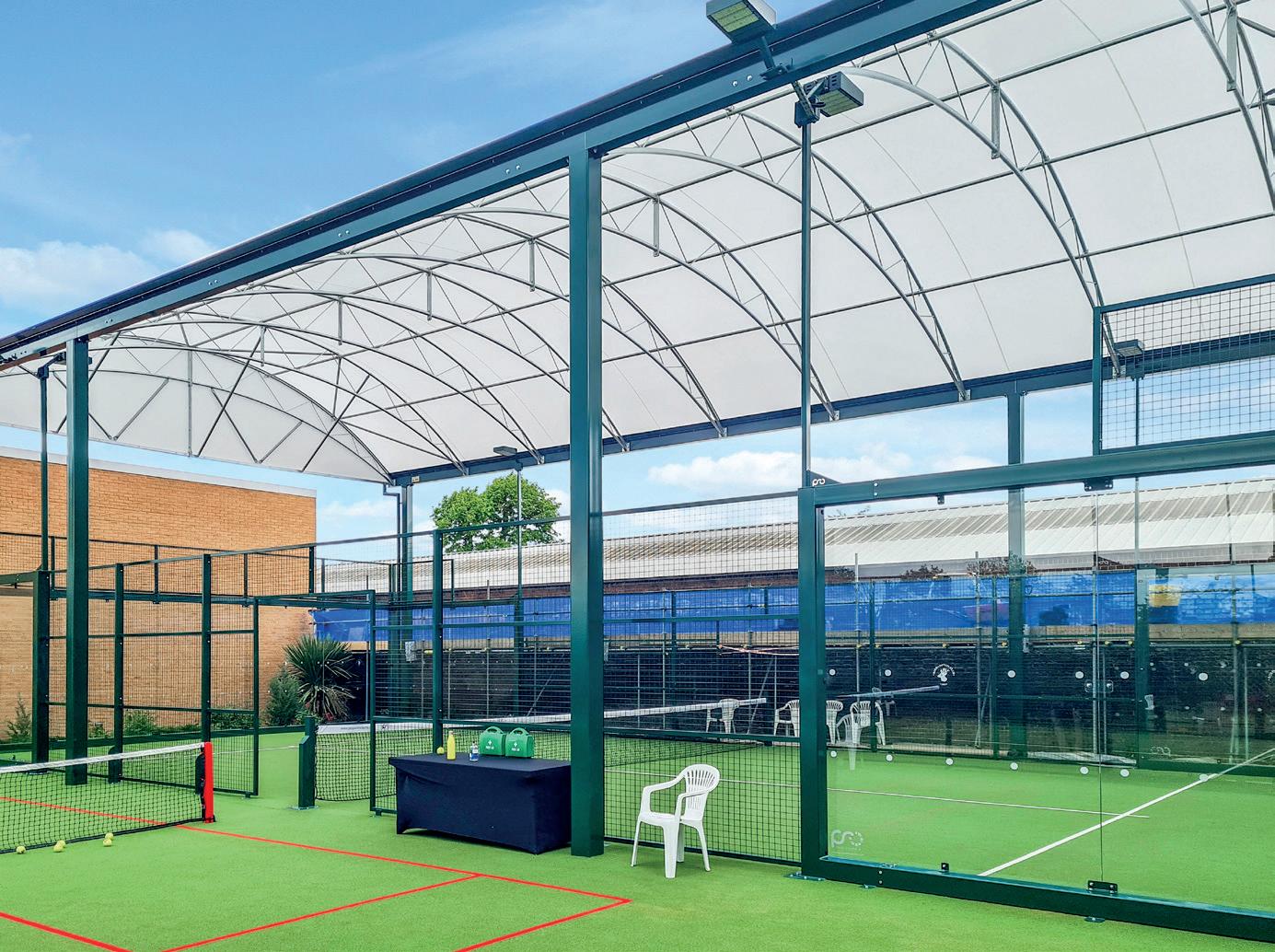

The design was respectfully tailored to the limited space available while maintaining conformity to set guidelines and allowing natural light to flood through the space and minimising the presence of bad weather for perfect results influenced by brand and setting.
Surftech is the authorised distributor of Orange Padel courts within the UK Market. Orange Padel International has more than 20 years’ of experience in engineering, designing and manufacturing of padel courts around the world. Orange Padel courts combine the Mexican roots of padel with Dutch technology and engineering qualities. The courts are developed for optimal playing comfort, reinforced structures for an extended life cycle and low maintenance.
Our technology and production procedures provide custom made padel courts. For us, it’s all about the players’ satisfaction
Padel 10 specialises in padel court manufacture, installation and maintenance. The company has utilised its experience in iron and glass hardware and has been involved in padel projects since 2007. In the UK, the company has partnered with SAPCA member Rocklyn.
Our courts are designed, manufactured, and developed in Barcelona

Roehampton is a key example of how quality and design can combine to create an elegant structureSurftech distributes Orange Padel courts in the UK market Fordingbridge recently completed a project in Roehampton Padel 10 has partnered with SAPCA member Rocklyn











Ilike to do things properly” is something you’ll hear a lot from Jamie, who is Head of Sports and Specialist Structures at Smart-Space. With a keen interest in sports of all kinds, and over eleven years working in events and instant buildings, Jamie is well placed to guide and support the company’s sports sector customers.
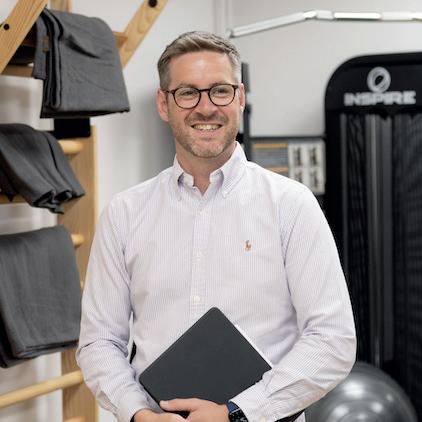
Dismissing the term ‘sales person’ Jamie maintains that he listens well, understands what’s needed and advises on options, best use of space, likely considerations, and best value.

“As a business Smart-Space is all about its people” explains Jamie. “We’ve grown significantly in the last couple of years and that has led to building teams who know their stuff. We have specialist people who know everything there is to know about planning permission, ground inspections, drawings, health and safety, finance, admin, warehousing, operations and, of course, building – the team is a good one.”
With a previous background in staging large-scale, prestigious events utilising many instant buildings Jamie knows that only a can-do attitude will work. “My
attitude reflects the company’s approach. We create buildings that work. For example, we’ve worked with Stratford Padel Club in London since its inception. It has recently extended its number of courts as the guys there have been enjoying phenomenal success – we’re very glad to be involved.”
Jamie and the Smart-Space team are currently working with several UK organisations to create more playing opportunities for padel and other sports. Jamie understands how it works – as a specialist but also as a player, coach and father of three.

“The UK needs more facilities and ready access to a wider variety of sports in every community. Bringing more sport, especially padel, to our communities is a win win for everyone. I am certainly much happier and healthier with access to sporting facilities.” ●

My attitude reflects the company’s approach. We create buildings that work
Jamie SouthamThe team at Smart-Space has a breadth of expertise and experience



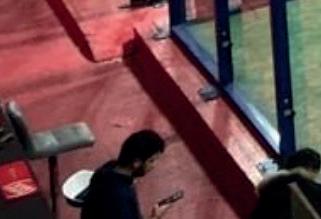


ALL WEATHER PLAY I REVENUE STREAM I FLEXIBLE
PERMANENT AND TEMPORARY SPORTS HALLS FROM SINGLE COURT TO MULTIPLE COURTS
Head of Sports and Specialist Structures
Jamie Southam: 07498 213674

jamie.southam@smart-space.co.uk

Padel fans - talk to us about the options for increasing padel across the UK. We can supply instant sports buildings (that don’t need foundations) right through to turnkey, permanent sports venues. Our flexibility means you get to play padel whatever the weather - even if you just have an unused piece of land or neglected tennis court to cover to create a padel facility. Talk to us to find out how we can bring padel to your neighbourhood.
The Premier League, The FA and Government’s Football Foundation has supported grassroots sports facilities projects worth more than £2 billion since 2000 - and has ambitious plans for the future. We speak to the people that make the foundation “tick”
I joined the Foundation in March 2017 as a regional engagement manager in the North East and Yorkshire, responsible for supporting prospective applicants to develop projects that would deliver strong social outcomes and provide a great return on investment.
For nine years before joining the foundation, I worked in football development roles for three different county football associations across Yorkshire, starting with East Riding FA and then moving to West Riding FA, both as football development officer and lastly joining Sheffield & Hallamshire FA in 2014 as county development manager.

Prior to my current role, I was senior programme manager responsible for the development of our Sport England National Lottery funded Active Through Football programme, alongside the creation of the Football Foundation PlayZones programme, which aims to build multisport recreational facilities in priority communities across the country.
In my role as Head of Delivery, I oversee a team of 20 delivery managers and officers, who operate across England to activate projects identified within our Local Football Facilities Plans and ensure they deliver against the objectives of our Measurement Framework.
I work closely with our team of senior delivery managers to continually monitor
our projected and actual performance, and to ensure that as a team we’re collectively making the right funding recommendations and maximising the use of our investment. My role enables me to work with colleagues across the foundation, our funding partners and a variety of external partners across any given week, whilst also getting the time to meet with clubs, local authorities, schools and a host of other organisations across the country that benefit from foundation investment.
Investment need is determined via our Local Football Facility Plans, which we developed for every local authority in England between 2017 – 2020. The plans were produced in partnership with local authorities, county FAs, and other community stakeholders. These plans act as a blueprint for the grassroots football facility improvements that each community needs and deserves across the country. We’re now refreshing these plans based on population growth,
team growth and increased facility demand in the years since their publications. Given our focus on multi-sport investment, we’re also working alongside national governing bodies from across different sports to identify their priorities alongside football. 90% of the investments we make will be determined by this blueprint – and it’s the delivery team’s responsibility to work alongside key community stakeholders to activate these plans and develop the projects that are strategically important.
Our team is split across three regions and made up of three senior delivery managers, 10 delivery managers, three delivery officers, one senior facilities planning manager and three facilities planning managers.
Each delivery manager is responsible for operating across a select number of county FA areas, and in close conjunction with the facility and investment teams across each county FA.
The team continuously engage with key stakeholders across local authority areas in
their region to activate the plans and build up a pipeline of prospective projects that are then supported to develop great outcomes. Close working takes place with the technical project manager team at the foundation to ensure design, procurement and delivery compliance so that when applications are submitted and successful funding decisions are made, construction can commence at the earliest opportunity and community usage can begin as soon as possible!
We’re currently working up a pipeline of projects for our next financial year which would lead to £100m of investment from the Premier League, The FA and government across our investment priorities, including 80 3G football turf pitches.

The pipeline includes the first phase of the Football Foundation PlayZones programme –which we hope to make funding decisions on and see constructed later this year – as well as hubs in Leeds. The latter are expected to join the recently-funded hubs in Derby and Wigan that are expected to open this spring.

What’s your background and when did you join The Football Foundation?
My previous role was in student support at a university, where I worked within a team to provide a frontline welfare response to over 8,000 students during the pandemic. I joined the Foundation in October 2022. I’ve played football for thirteen years and after volunteering at the women’s EURO tournament this summer, decided to follow my passion and pursue a career in football, supporting the improvement of grassroots facilities across the country.


The grant support executive role covers a wide range of tasks. One of our key responsibilities is carrying out the assessment of capital and revenue grants under £25,000. In this, we support applicants with their queries and work to make sure the process runs as smoothly as possible. We manage the process from start to finish; from performing the initial grant assessments right through to processing the grant claim. We also manage most enquiries that come to the Foundation and


either work to resolve them ourselves or signpost them to the most relevant team.
How many applications does The Football Foundation receive each year - and has that number increased?
The number of applications fluctuates at different times during the year. We tend to receive more applications at key points in the year, which is usually at the beginning or end of the season when clubs and organisations are reviewing their equipment for the upcoming season. The type of application also varies throughout the year. For example, we receive more applications for our portable floodlight grants in the winter when it’s getting darker.
How much post-award work is there involved in successful applications?
The main post-award work we do in small grants relates to our Grass Pitch Maintenance Fund. This is an ongoing six-year grant programme aimed at enhancing and sustaining the quality of grass pitches around the country. From year one to year six we work with applicants to monitor the progress of their grass pitches. This is done through annual grant claims and the completion of PitchPower Assessment Reports. Completing these reports is part of the terms and conditions of our grants and enables applicants to get feedback and recommendations about their pitch quality from the Grounds Management Association. Working with applicants across the six-years enables us to develop relationships with them.

What’s your background and when did you join The Football Foundation?
My first job was at KKP – a management consultancy which specialises in leisure, sport and regeneration – where I was involved in projects for Sport England, Sport Ireland, Active Partnerships and other sport organisations. From there, I joined Trafford Council as its first sport and physical relationship manager, where I collaborated with a wide range of partners to increase participation and tackle inequalities.
The opportunity to join the foundation was a once in a lifetime moment. I joined the team in March 2022 as facilities planning manager.
In my current role I help to ensure that the foundation achieves its objective of increasing physical activity levels among the four key priority groups facing the greatest inequalities (lower socio-economic groups, women and girls, disabled people and ethnically diverse communities). I help do this through a mix of capital and revenue programmes, including Active Through Football and Football Foundation PlayZones.
What does your job involve “day to day”?
No two days are ever the same. An ‘office’ day is an opportunity to check in with the gifted team I work with – we’re working at pace to deliver the first phase of the Football Foundation PlayZones programme so it’s a busy time meeting with design consultants, smart access providers and consortium partners to realise our ambitions. Meanwhile, a day on the road could involve meeting with some of our partners who are delivering programmes to discuss progress and bring partners together. One of the key aspects of my role is to ensure that community engagement underpins our work, and that place-based working is embedded in our processes.
Could you describe your current programmes?
Active Through Football is our opportunity to learn from doing things differently; aiming
to create sustained behaviour change by using a “place-based approach”.
Through this programme, we’re working with people who face some of the greatest inequalities to being physically active. By embodying asset-based approaches to community engagement and building trusting relationships, we’re starting to unlock some really exciting work.
There are amazingly talented individuals and teams working on the 25 Active Through Football programmes we have up and down the country. The projects share so many stories about the impact the programme is having, which is incredible. One standout story is the Active Women programme in Leicester. The lead, Rukhsana, is an inspiration – she is determined to make a positive difference and gives so many women the opportunity to take part. She says: “everyone can be part of football”.
What can we expect to see next?
It’s a really exciting time for the team!
We’ll start to see some of the first Football Foundation PlayZone sites being developed this spring and summer, so watch this space!
The Football Foundation PlayZone programme tackles inequalities in physical activity and access to facilities by funding community-led spaces. By 2025, we’ll be developing up to 300 PlayZones, including both new builds and refurbishments of existing spaces. We’ve recently launched the London phase of the programme, so we’re excited to see the plans that come forward.

What’s your background and when did you join The Football Foundation?
I joined the Foundation four years ago. My background is in HR and I’ve spent the last 10 years working in the charity sector as I get real satisfaction from knowing that my work makes a difference. I chose to join the Foundation because I’m a keen football fan and play sport in my personal life, so was excited to join a charity that harnessed the power of sport to change lives.
What does your role entail “day to day”?
We’re a small team, so I get involved in every aspect of HR – from recruiting, developing, managing, rewarding and retaining our most valuable asset, our people!
A typical day might involve delivering training on our culture and values to a new team member, working with our ‘Culture Champions’ to design our annual survey, working with our EDI Lead and MarComms team on some initiatives to ensure our teammates are engaged with the amazing work the Foundation does.
How would you describe the Football Foundation’s organisational values?

We call our organisational values our Four Corners. We are a football charity after all! We’re Star Performers; we’re a United Team; we’re Passionate Supporters; and we’re Fair Players. We are Star Performers is all about always striving for excellence to help us transform lives and strengthen communities. We’re a United Team is about supporting each other and working together to deliver the greatest impact wherever it’s needed most. We’re Passionate Supporters is about supporting the game in any way we can, and making sure we make things as easy as possible for our applicants. We’re Fair Players is about being inclusive and understanding diversity allows us to tackle inequalities through everything we do. Coming up with them was a genuinely collaborative effort – we took on
board input from everyone at the Foundation when developing them.
And how do those values drive the Foundation’s overall strategy?
Our Four Corners underpin everything we do and are woven into all of our People Processes and Policies. We make sure our Four Corners are embedded at the foundation by incorporating them into all our job descriptions and by asking our managers to discuss them with team members at Performance and Development Review meetings. We also recognise and celebrate these values in our team members at our annual VIP (Values in Practice) awards. We also have a group of “Culture Champions” from across the Foundation who help us embed the values and the positive culture we wish to see at the Foundation.

The Marcomms team gets involved in lots of projects, so our work is varied and every day is different. Some days I will be at an opening event, another working on a campaign strategy and others capturing content at our funded sites to tell the stories of the difference our grants are making.
I lead the delivery of creative and impactful marketing and communications plans – identifying all the tasks that need to be completed, assigning and briefing them, monitoring progress and ensuring projects are delivered on time and within budget. These plans promote the ambition, programmes and campaigns of the Foundation, driving positive coverage.

Our focus is to ensure communities across the country know about all the funding and guidance we offer to help them access the quality sports facilities they deserve. We do this by telling success stories of the impact of our funding and running campaigns to promote our offering.

When planning our campaigns, we first need to understand who we want to target and where to find them, then we move on to strategy and what we're trying to achieve –essentially this is about setting our objectives. The final step in campaign planning is looking at our tactics, the things we need to do to achieve our objectives. This includes things like creating social content, showcasing our campaign in the media, or reaching out directly to our target audiences via email.
We kicked off this year with our Let’s Go 2023 campaign to raise awareness of all the funding opportunities available. We launched the campaign across our digital and social channels with a suite of graphics depicting each of the funding opportunities
alongside an animation which wraps up the full line up of support we have coming on offer this year. We’re also running a paid social media campaign to target the seldom heard groups that often face the greatest barriers to playing sport and getting active.
Last month, we launched HERe To Play, celebrating our biggest ever commitment to delivering facilities that provide equal access to women and girls. We kicked off the campaign at the opening of The Jill Scott Pitch in Jarrow, which received national coverage in all the main news outlets.
The Foundation is on a mission to revolutionise the quality of grass pitches across the country so we run a year-round Power Up Your Grass Pitch campaign with key activity between November and March. Despite around 90% of the affiliated football game being played on grass, we know that thousands of players are left disappointed every year when their matches are cancelled due to poor quality pitches.
Our campaign signposts people to use PitchPower, our free grass pitch inspection web app, so clubs can benefit from the knowledge and advice they need to improve the quality of their grass pitches. The campaign is currently targeted at grassroots groundkeepers but this year, we plan to widen the audience to players and parents.
Our goal is to ensure that by 2030, grassroots football has 20,000 “good” quality pitches, which will mean fewer cancellations.
I’ve been with the Foundation for one year!
Before that, I spent 20 years in the natural resources sector before moving into the third sector, where I spent 12 years in organisations that make a difference to people’s lives.
I’ve worked across operations, commercial and of course finance so have strong leadership and financial management skills. I joined the foundation as the organisation strongly aligns with my personal values – making a positive difference to people’s lives.

Being directly responsible for finance and planning, data insight, procurement, project management and technology, as well as being part of the executive team, I pretty much have a bird’s eye view of everything that is happening across the organisation.
I can work across both operational and strategic areas in one day ranging from reviewing business cases, approving purchase orders to developing strategic plans and vision for the future.
The Football Foundation receives money from the Premier League, The FA and the DCMS, through Sport England. This is matched with partnership funding and awarded as grants to create outstanding grassroots facilities, with around 60% coming from the Foundation and the other 40% from local partners.
Since its creation in 2000, the Foundation has unlocked over £2bn investment into delivering outstanding facilities where the demand is greatest, and impact will be strongest.
In October 2021, the Government committed an additional £205m to grassroots facilities in England over the next three years as part of their Comprehensive Spending Review. This has enabled us to scale up and deliver more positive impacts in a quicker and more efficient manner.
We now invest more than £100m a year into grassroots football – a significant increase from when we began at £40m a year. To step up to the challenge of delivering this increased level of investment, we’ve increased our workforce significantly.
We’ve set ourselves key performance indicators (KPIs) to ensure that we’re delivering against the objectives to which we’ve agreed with our funding partners. Progress is reviewed every month by the foundation’s executive team, every quarter by our board, and regularly shared with the rest of the team to ensure we all remain focussed on delivery.
These KPIs include targeting our investment at those who will benefit from our facilities the most, which we do by investing half of our funding into the most deprived and inactive communities, and also not investing into a site unless it ensures equal access to opportunities to play for women and girls.
We also want the facilities we fund to have a benefit to participation in sport and physical activity beyond football. That’s why by 2025, we plan to commit 40% of our investment into projects that support both football and an additional sport, such as rugby, cricket, netball or basketball.
We have big plans to revolutionise England’s grassroots facilities and thanks to the investment of our funding partners, we’re well on our way. ●
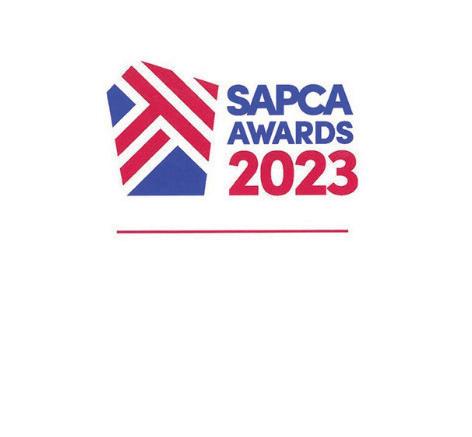

Award Winning EnviroStik Aqua-Fix Adhesive is a single component moisture-curing adhesive, formulated for the secure seam jointing of carpets using special geotextile based tapes. Its tolerance to use in adverse weather conditions or when carpets become wet due to exposure to rain before bonding allows work to proceed even when other adhesives may not produce acceptable bonds. Final bonds are fully resistant in the long term to all climatic conditions.

• Single part, no mixing





• High resistance to weathering and environmental influences








• No excessive foaming, even with high moisture levels
High performance adhesive for fixing artificial grass even in wet weather






The way sports facilities are designed, managed and maintained is undergoing a huge technological shift. Those building and operating arenas and other facilities are increasingly looking to tech to drive high levels of performance, alongside stimulating business growth and efficiency.
For operators, new systems are creating efficiencies through day-to-day business operations, while those responsible for construction and maintenance are now able to use data to guide decision making. And customers get substantial benefits also, with centrally located maintenance records and evidentiary support for potential legal challenges relating to both the work carried out and all other aspects of the facilities provision
It’s clear that the sport and physical activity sector is adapting well to the use and impact of data analytics to help shape organisational performance, support Informed decision making and align strategy. One company embracing the digital world, is internationally recognised synthetic sports surface provider, SIS Pitches, who

have implemented workflow management software into their operations in order to digitise and streamline their business processes. Their portal system helps customers manage their pitches by generating an exclusive online environment that clients can log into to monitor progress.
“We chose to use customer portal and scheduling systems because they can be fully customised to our needs and will be a great resource to our clients to be able to monitor their facilities maintenance,” says Luke Edwards Technical Director at SISPlus.



Sports surfaces test institute and global consultancy practice, Sports Labs, moved its scheduling systems online in 2020.
“Our teams are that busy at the moment, that if we were still using our old programme we would be completely lost.” says Richard Nixon, Technical Director at Sports Labs. The company is now expanding the use of the system, integrating remote monitoring of pitches and surface assessments using an app with instant report generation. Facility providers are also taking advantage of

new cloud-based software systems. Goals Soccer Centres moved the management of its 44 centres onto an online platform last year, allowing club managers, area managers and the company’s leadership to centrally track and store maintenance and critical health and safety information as well as streamline fault and issue reporting and resolution. “Our digital transformation ensures better management of our pitches and facilities.” says Jean McCormack, Goals Soccer Centres’ Facilities Manager.
All three organisations have contracted Nottinghamshire-based software organisation Passport365, a facilities management and workflow management tool. Passport365 works internationally with clients, optimising operations, strategy and performance of sports & leisure facilities and those who build and maintain them. From automated report generation to customer portals and contact management and everything in-between, the organisations are reforming traditional paperbased procedures, digitising and automating critical elements of business operations.
National governing bodies of sport, such as England Athletics, are also embarking on technological transformations, using software and data to improve insight to drive decision making. England Athletics’ partnership with user interface and technology company, Conduiit, revolutionises
its approach to data, its use and accessibility, enabling the delivery of tangible benefits across the athletics community.
“We will have access to a detailed analysis of every athletics facility in the country,” says Ed Hunt, England Athletics’ Facilities & Planning Manager.
“From financial profiling: income, expenditure and lifecycle costs; to usage and catchment data, the Conduiit software platform will help to paint a detailed picture of athletics facility provision in England.”

In conjunction with customer expectations, these technological advances can only increase in the future with new capabilities being introduced every day. Furthermore, new business intelligence reporting can transform data from being inaccessible into dynamic content, that can be used to make decisions and drive strategic change. ● More info: www.passport365.com

National Governing Bodies of sport, such as England Athletics, are also embarking on technological transformations, using software and data to improve insight to drive decision makingData can now be harnessed to help maintenance schedules © SHUTTERSTOCK/SCHAMIN
When it comes to creating outdoor sports and play areas, the choice of playing surface is among the most important decisions to make. The type of surface is dictated not just by the sports it will host, but the level of user, the surrounding environment and the budget available.
There are many surface types – from




polymeric rubber and PVC to macadam, asphalt, natural turf and artificial turf – and each has its individual characteristics.

Here are some examples of recent outdoor sports facility projects – as well solutions for improving the aesthetics of outdoor tennis and basketball courts – created with the help of SAPCA members.




PlayTop, the playground brand of SAPCA member Conica, worked with Manchester United and England forward Nikita Parris to provide a lasting new playing surface for the MUGA at Princes Park Methodist Centre in Toxteth, Liverpool – the area where Parris grew up.
PlayTop installed its SUDS Bond product with a silver fleck to create a porous and durable rubber surface that is softer underfoot than the previous macadam surface. With line markings for basketball and football – and a new 2m high championship MUGA fence – the MUGA now allows visitors to play sports in one area, while leaving enough room for other activities and seating for family and friends.

In 2022, SAPCA member O’Brien Contractors completed an ambitious project to create a new home for Old Saltleians RFC in Water Orton. The development included the transformation of 17 acres of farmland into six natural turf pitches, a new clubhouse and parking. The profile of the landscaping has been engineered to provide a facility that flows seamlessly across the

site, while also making efficient use of the whole facility. The four, high-standard grass pitches are fully drained and incorporate an irrigation system to ensure that the pitches will be useable in all but the harshest weather conditions, while the provision of energy efficient led pitch lighting will allow activities to continue during winter periods making full use of the pitches.

Borders, Nike and JD
Sports partnered to create an innovative 3G football pitch at Manchester’s Moss Side. The facility at the Millennium Powerhouse is called ‘Move to Zero Manchester’, which derives its name from Nike’s journey to zero carbon and zero waste. The playing surface at
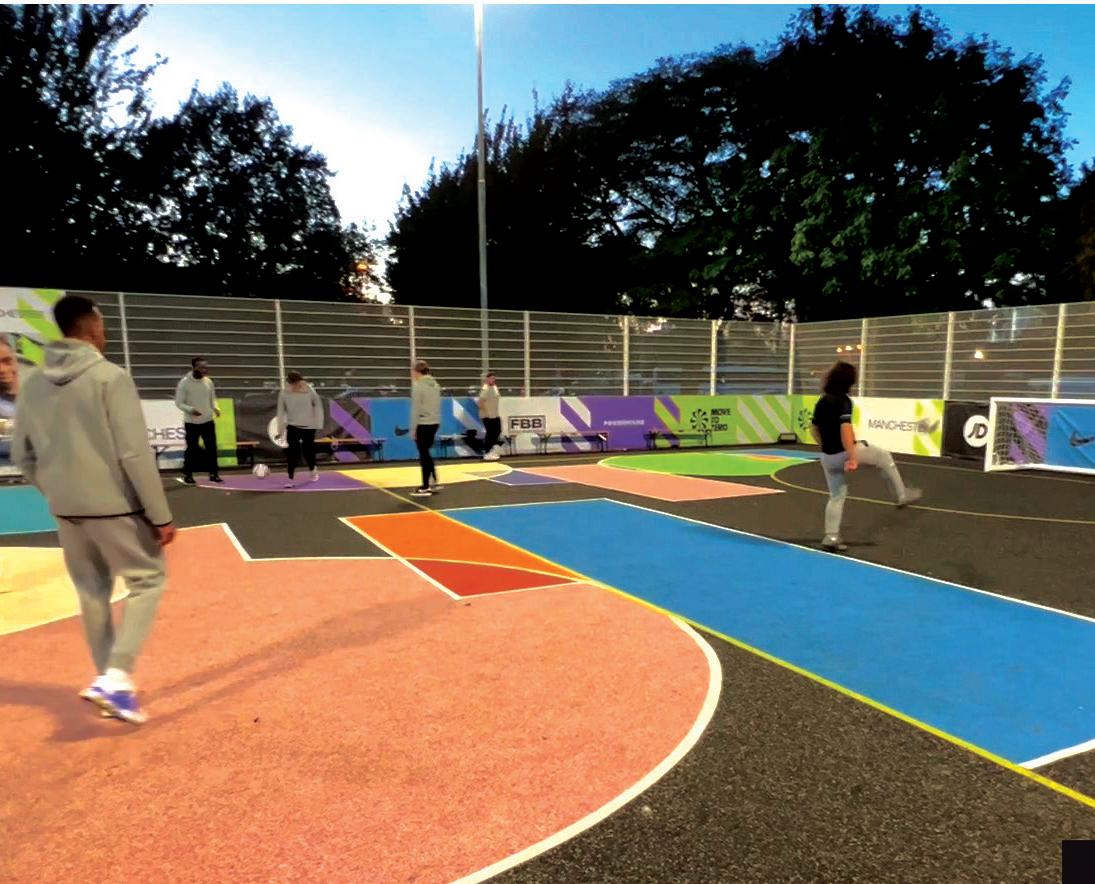
the venue utilises the Nike Grind process, which transforms manufacturing scrap and end-of-life shoes into recycled materials. Nike Grind creates environmentally friendly, high performance and durable surfaces through a unique mix of both recycled Nike rubber trainers and EPDM rubber.


ProPlay, the sustainable shock pad produced by SAPCA member Schmitz Foam Products, has been officially certified by the Dutch Hockey Association (KNHB) as a sub-base for hockey fields. ProPlay shock pads are produced out of collected residual foam sourced from high-end industries such as the automotive industry. Without Schmitz Foam Products giving these surplus foams a second life, they would likely end up in landfills or in incinerators. One of the facility projects to use the shock pads was recently completed at Dutch hockey club RHC Concordia. The club was forced to replace all their fields due to extreme flooding in July 2021 and wanted to invest in a durable and sustainable solution. As a result, it chose ProPlay as a subbase for its new artificial turf fields.

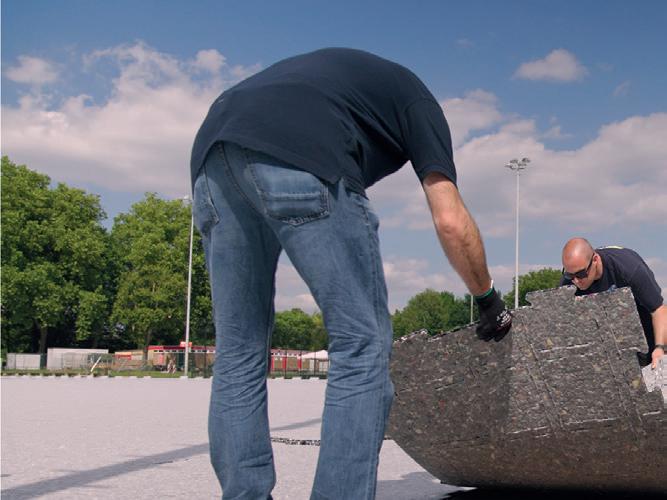
Brown, “rusty” spots that appear on the surfaces of asphalt-based tennis and basketball courts – or MUGAs – are surprisingly common. The cosmetically undesirable spots or streaks can often detract from the appearance of the court.







The cause of the discolouring is due to iron pyrites, which are found in flint gravels and in some aggregates derived from mining waste. Pyrites can cause a “rusting” effect when the conditions are right – usually when oxidation takes place in the presence of moisture and atmospheric oxygen.
Now, Britannia Paints has developed a remedy – the first ever, water-based, iron stain inhibiting binder. The product is an effective neutraliser of staining caused by iron pyrites. It is safe to use, environmentally friendly and, as well as nullifying the
spots, has been designed to bind the court surface to inhibit further staining – helping the surface last longer. This means that the inhibiting binder is suitable for both new and old courts.
We recycle plastic to make the football world of tomorrow more sustainable. At Polytan, we use upcycled materials to create the highest-quality synthetic sports surfaces in terms of safety and playability. We are passionate about providing ideal playing conditions for athletes in every sport – and doing so in the most sustainable manner possible.


www.polytan.com/sustainability










WE MAKE PLASTIC BETTER.






Island Games, an international sports event for the world’s small island communities, will finally take place in Guernsey this July. The event, which was due to take place in 2021 but was postponed due to COVID-19 restrictions, will see athletics disciplines take place at the refurbished Footes Lane Athletics Track.
The original track was constructed in 1991 and was beginning to show its age, leading to The States of Guernsey embarking upon an ambitious project to extend and refurbish the track and field event facility.

SAPCA member Labosport was chosen to design and manage the refurbishment project, which has seen the track extended from six to eight lanes and upgraded with a Conica AG World Athletics certified surface.
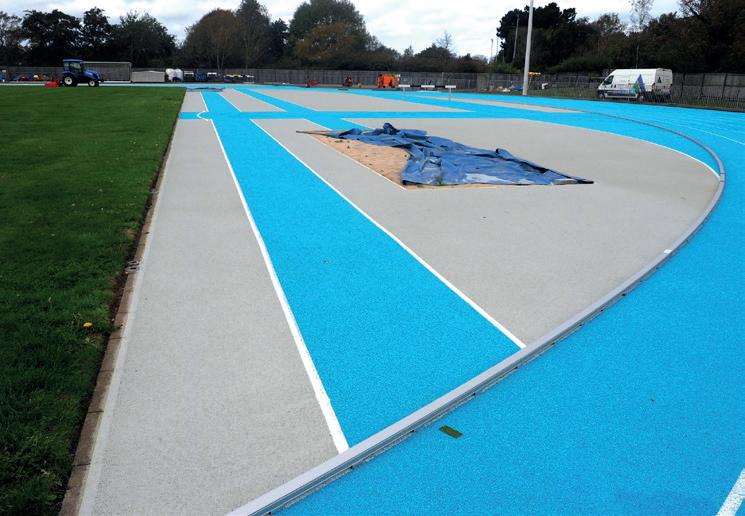

Cleveland Land Services Sport, in conjunction with fellow SAPCA member Playdeck UK, has installed a Conica Conipur SP sprint track as part of a brand new sports facility at Westway Sports Hub in Chorley.
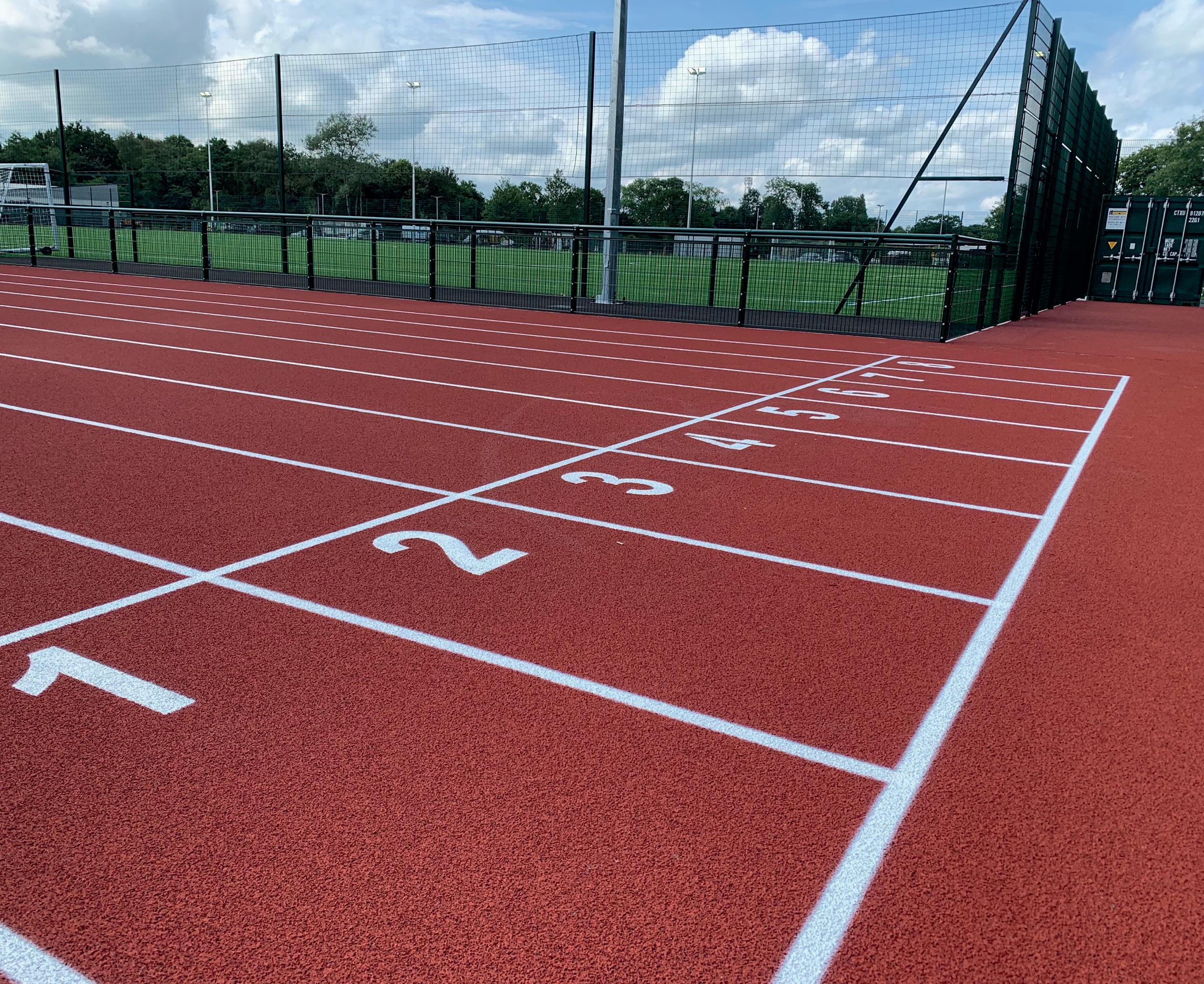
The 8-lane, 1,950sq m facility includes a floodlight 3G artificial grass pitch, sprint track, long jump area and accompanying changing pavilion on an open parkland site. Funded in part by the Football Foundation and Chorley Council, the project also included improvements to the existing natural grass pitches.
The Conipur SP sprint track is a polymeric finish created by spraying a structural polyurethane and rubber mix over a porous rubber base. This results in a water permeable, slip resistant and highly durable athletics surface, ideal for use by the local community.
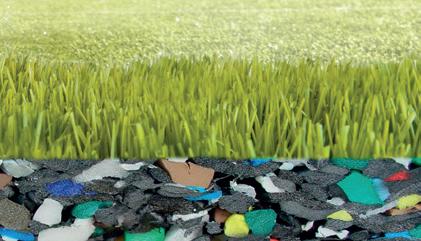







White Horse Contractors have begun the next phase of works that will create new training facilities for Queens Park Rangers FC. The SAPCA member has already constructed three new hybrid pitches with under-pitch heating, drainage and lighting at the club’s Heston complex.
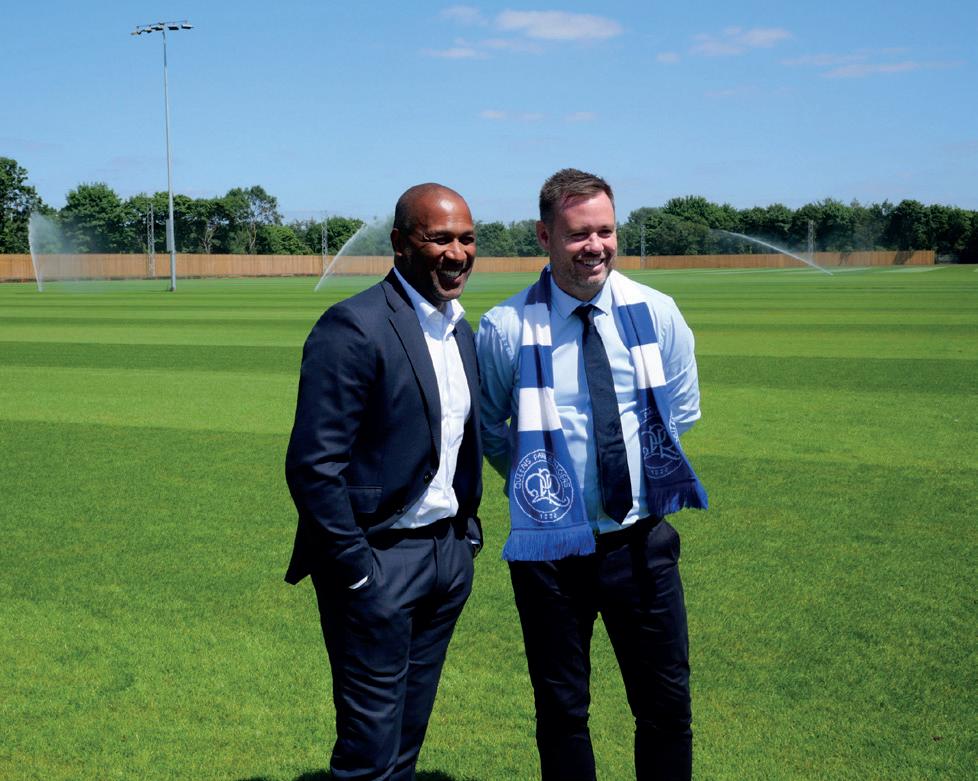
The training centre’s “Pitch 1” has been designed to exactly mirror the club’s home stadium Loftus Road’s pitch. The other two pitches are of similar specification to QPR’s Championship opponents. All three pitches, goalkeeping areas and the rehabilitation area are hybrid surfaces, using GrassMaster monofilament fibres.

Now, as part of £1m redevelopment works, White Horse has begun work with soft and hard landscaping of the facility. White Horse will also complete the installation of attenuation tanks around the buildings – a significant design consideration for the club, with planning policies relating to Sustainable Underground Drainage Systems (SUDS).
With new services being installed, and the planting and attenuation around the site and buildings already begun, the project is progressing well and White Horse looks forward to delivering a further first-class facility for the training ground.
SAPCA member Polytan has created the world’s first carbon-neutral synthetic turf for field hockey. The new Poligras Paris GT zero has been developed specially for the 2024 Olympic Games in Paris and is manufactured using sustainably farmed, organically based synthetic materials.
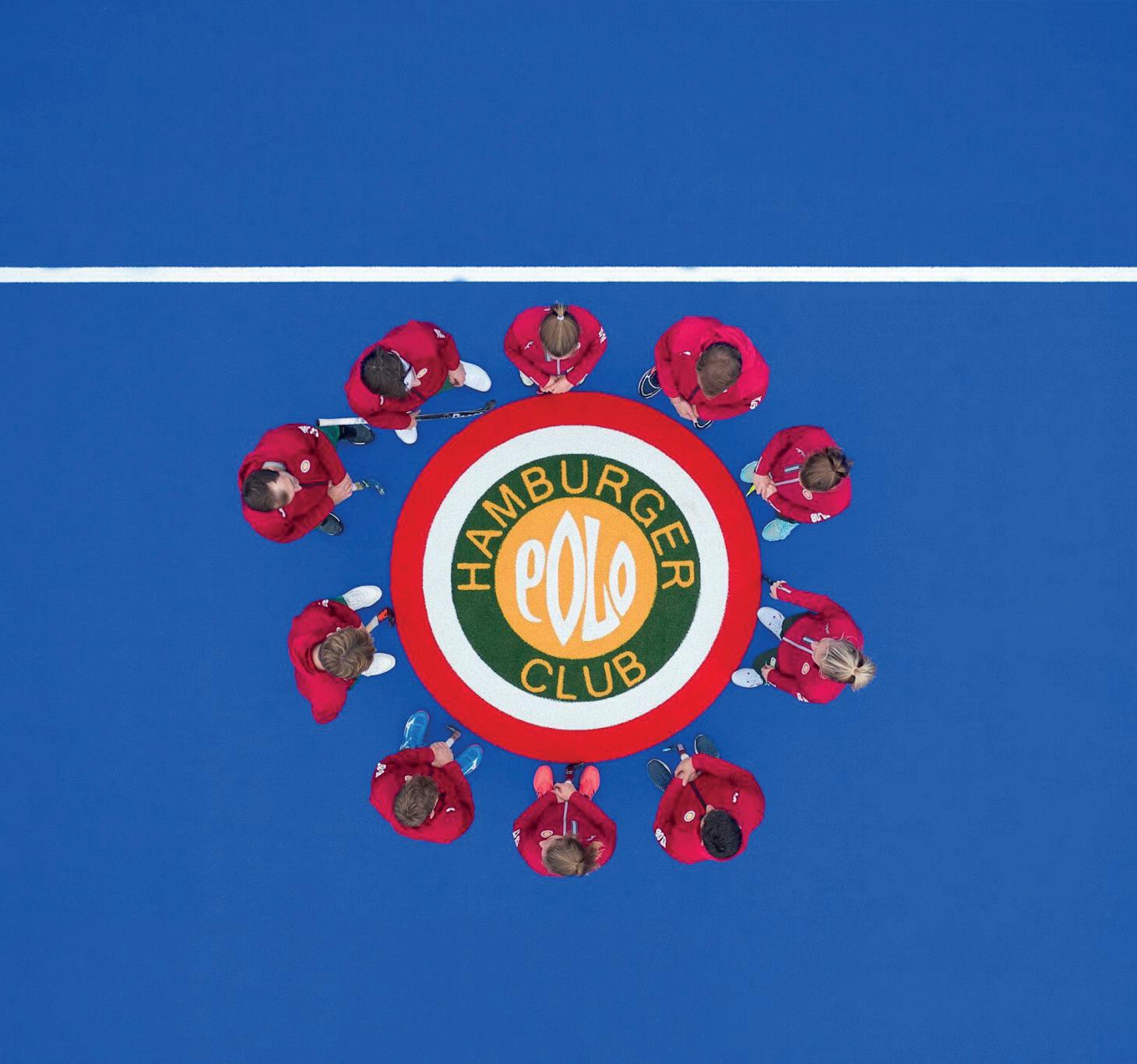
During the manufacture of the turf fibres, fossil-fuel-based polyethylene is replaced with organically based polyethylene. The “I’m Green” polyethylene is an organic plastic, utilising a by-product of sugar cane processing in Brazil made by Braskem, the world’s largest producer of organically based polyethylene.
Another major component in maximising the sustainability of Poligras Paris GT zero is the improved product design, which consumes less water than before. The surface uses Turf Glide, a new, patentprotected technology that reduces surface friction so that even less water is needed to reduce friction resistance and minimise the risk of injury. Polytan installed its first Poligras Paris GT zero hockey turf at the Hamburger Polo Club in Germany in October 2022.

Polytan creates world’s first climate-neutral synthetic hockey turfThe first Poligras Paris pitch was installed at Hamburger Polo Club
● Amorim Sports provides solutions for artificial turf systems for sports applications.
● Produced with cork, these components, used in artificial sports pitches, contribute to a positive impact on the climate.
● Amorim Sports’ Nature infills have a negative carbon balance of -72.5kg CO2 e/kg.

Amorim Sports’ Nature range is composed of 100% natural cork performance infills. The products are certified and specifically designed for the use in sports pitches. They help improve players’ comfort and foster a lower surface temperature, while providing an advantage in terms of sustainability.
These figures and analysis reinforce the company’s commitment to develop a business activity that promotes and offers products with proven capacity to retain higher CO2 sequestration levels than the CO2 emissions associated with their production.
The study was based on a tool specifically developed by PwC –PricewaterhouseCoopers, which makes it

Amorim Sports’ infills are designed specifically for the use in artificial sports pitches

possible to estimate the Carbon Footprint associated to granules produced from cork and cork waste, from the management phase of the cork oak forest, transport of these raw materials, processing and packaging, to the factory gate, using the Cradle-to-Gate approach (which does not include transport, application or end-of-life destination).
The use of cork infills in sports systems - in particular football, rugby and other sports fields - returns part of nature to an artificial turf system, bringing it closer to the characteristics of natural turf. Since it is a natural material, cork offers several advantages over traditional infill solutions, including a more natural look and feel, the absence of toxicity and a neutral odor.

Cork infills are valued by athletes given their performance, great moisture absorption capacity and absence of agglomeration of granules that deliver technical quality to pitches and create excellent playing conditions.
The unique characteristics of this 100% natural, renewable, and recyclable raw material therefore guarantees a balance between performance and environmental sustainability. ●
Getting the lighting right is one of the most important design aspects of any sports facility. We look at some of the di erent solutions created by the leading lighting specialists



In recent years there have been significant developments in the use of LED (light-emitting diode) technology and LED light sources. Thanks to these advancements, LED solutions now have the ability to offer comparable brightness at a fraction of the energy cost when compared to traditional, metal halide lamps. LED lighting has also proved to be more durable and show a lower reduction of performance over their service life.
As a result, LED has become the preferred choice for sports facilities looking for a lighting system. It is estimated that around 90% of



new installations now utilise LED technology, with some leading lighting manufacturers no longer producing metal halide systems.
The advantages of installing a LED system include lower running costs, longer-lasting light fittings, better control of light spillage outside the playing area, greater flexibility in programming (such as to give different colour options), and reduced maintenance.
On the flip side, LED installations do have a higher initial capital cost, which facilities will have to measure against a forecast of reduced running costs, in order to determine a likely payback period and

overall financial viability. A rule of thumb is that the more hours of floodlit use there are, the more a facility will save in the long run. Having independent, specialist technical support can be very useful, in order to help navigate through a complex subject. Sports lighting contractors or consultants can assist with initial budget costs for projects, but it is important to recognise that the market is very volatile at the current time, due to a variety of factors – such as the availability of raw materials, the effects of the pandemic, rising fuel prices, and the increased costs that are being seen across the whole construction

industry and the wider economy. While there are many companies that offer to undertake electrical and lighting work, it is essential to choose between contractors that are genuinely specialists in the sports facility industry, who have the requisite expert technical knowledge and experience. Visting previous examples of their lighting installations at similar facilities is always time well spent.

Choosing a lighting contractor that is a member of SAPCA gives important reassurance that the company is a specialist in lighting solutions – and has a track record of delivering successful projects.





Choosing a lighting contractor that is a member of SAPCA gives important reassurance that the company is a specialist in lighting solutions – and has a track record of delivering successful projects
“
Manchester Regional Arena is a multipurpose stadium in Manchester, which houses indoor and outdoor track and field facilities. The outdoor track includes covered seating for 6,500 spectators and is the venue for the Paralympic World Cup, the AAA’s annual National Athletics Trials and a host of regional athletics events. The arena regularly welcomes school and community sporting events with an eight-lane, 400-metre outdoor track and an indoor athletics hall.
The arena approached the Abacus lighting team to upgrade its existing lighting systems to enhance the sustainability of its facilities and effectively control light pollution for the venue and surrounding area. The scope of works involved replacing the existing halide floodlights for the track and infield, as well as replacing the under canopy lighting which had become unreliable and costly to

Manchester Regional Arena’s existing masts were utilised and now carry the new LED floodlights
run. The challenge was to reuse the existing infrastructure, while ensuring the existing high masts can safely carry the additional weight of the LED floodlights, all with the pressure of guaranteeing the works are completed within a tight time frame during a busy summer schedule for the arena. Abacus delivered the installation that included 76 Challenger 1 LED floodlights, which achieved an average maintained illuminance of 500 lux with a minimum uniformity of 70%. The under canopy lighting was replaced with 32 sets of F-LUM Midi LED floodlights to ensure the spectator seating is adequately illuminated while reducing energy usage and maintenance costs.

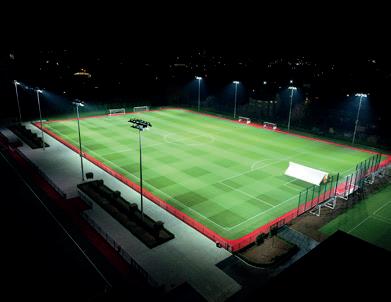




Carbon8Lighting was approached by The Glasgow Tigers Speedway to help illuminate the race circuit to TV standards. As there isn’t currently a lighting standard (or guidance) in place for broadcast quality lighting, Carbon8Lighting set out to do its own, in-depth study of what was needed.
Carbon8Lighting’s Sales Manager, Trevor Jacobs, travelled to Scotland and spent a few days surveying the track and speaking
to stakeholders, from TV production companies to the riders themselves. With the individual needs taken into consideration, Carbon8Lighting installed a solution that combined Carbon8Lighing Discus Floodlights with differing power outputs and a mixture of lenses. The result was a resounding success with riders and spectators, and the design has set an unwritten guide for illuminating speedway tracks for televised events.

The new lights maximise energy savings for the club
The lights have been a huge hit with both riders and spectators
Last year, SAPCA member JHP Electrical Services and lighting manufacturer Lumosa set up a competition to provide four free luminaires and a LumosaTouch control system to be installed at one lucky tennis club in the UK.
The competition winner, Wythall Tennis Club, has now had its old 1 Kw metal halides – originally installed way back in 1990 – replaced with Lumosa’s new CS460PRO LED system that meets the LTA standard, while also providing a convenient training level at 200 lux to maximise energy savings to over 75%.
The installation, by JHP, was such a success that the club has ordered four additional luminaires for the club’s other court. The feedback from the club, which has more than 150 members, has been amazing, with the club’s coaches commenting that the newly installed lights are the best they’ve played under.
Cradley Town FC was in need of a new lighting system and approached Floodlighting and Electrical (F&E) through the exclusive partnership it has with the Birmingham County Football Association (BCFA). Following a full assessment and site visit, (F&E) presented the club with a fully detailed plan, design and a quotation for an LED solution.
From the engineering work to the final light test, F&E was there every step of the
Oakengates Leisure Centre’s old lighting scheme was expensive, inefficient and not fit for purpose during the dark and cold seasons. In a bid to upgrade the facility, it appointed Kingfisher Sport to design and provide a low maintenance, cost effective alternative.
After an initial evaluation of the existing equipment, faults were discovered with the pre-existing 2kW metal halide luminaires and masts. With no option but to install a complete scheme replacement, the Kingfisher Sport Team offered AMNIS Match luminaires and 15m base-


way to deliver on the core objectives of the project. As a result, Cradley Town FC – which plays in the Midland Football League Division 1 – now has an LED floodlighting system that provides the club with the required FA approved lighting level and a better lighting experience for players and spectators alike.

F&E is a member of SAPCA and has more than 40 years of experience in lighting solutions – from elite stadiums to grassroots venues – across the UK.
hinged columns, which not only saved money but reduced maintenance time on site. Designed to meet both BS EN 12103 and England Athletics standards, the site perfectly aligned with Class II level of play. The AMNIS luminaires ensure
accurate uniformity throughout whilst maintaining comfort with its flicker free output using reflector technology system. The overall renovation promoted cost savings and ensured the scheme would stand the test of time.
































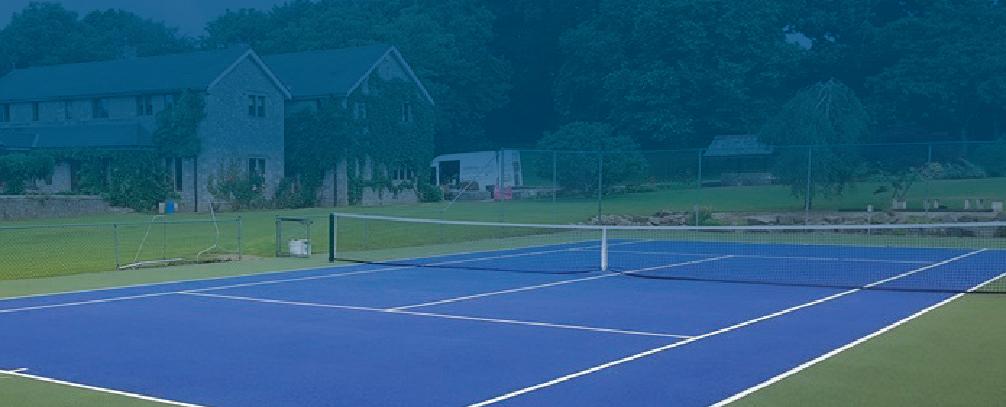





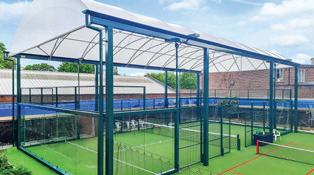
















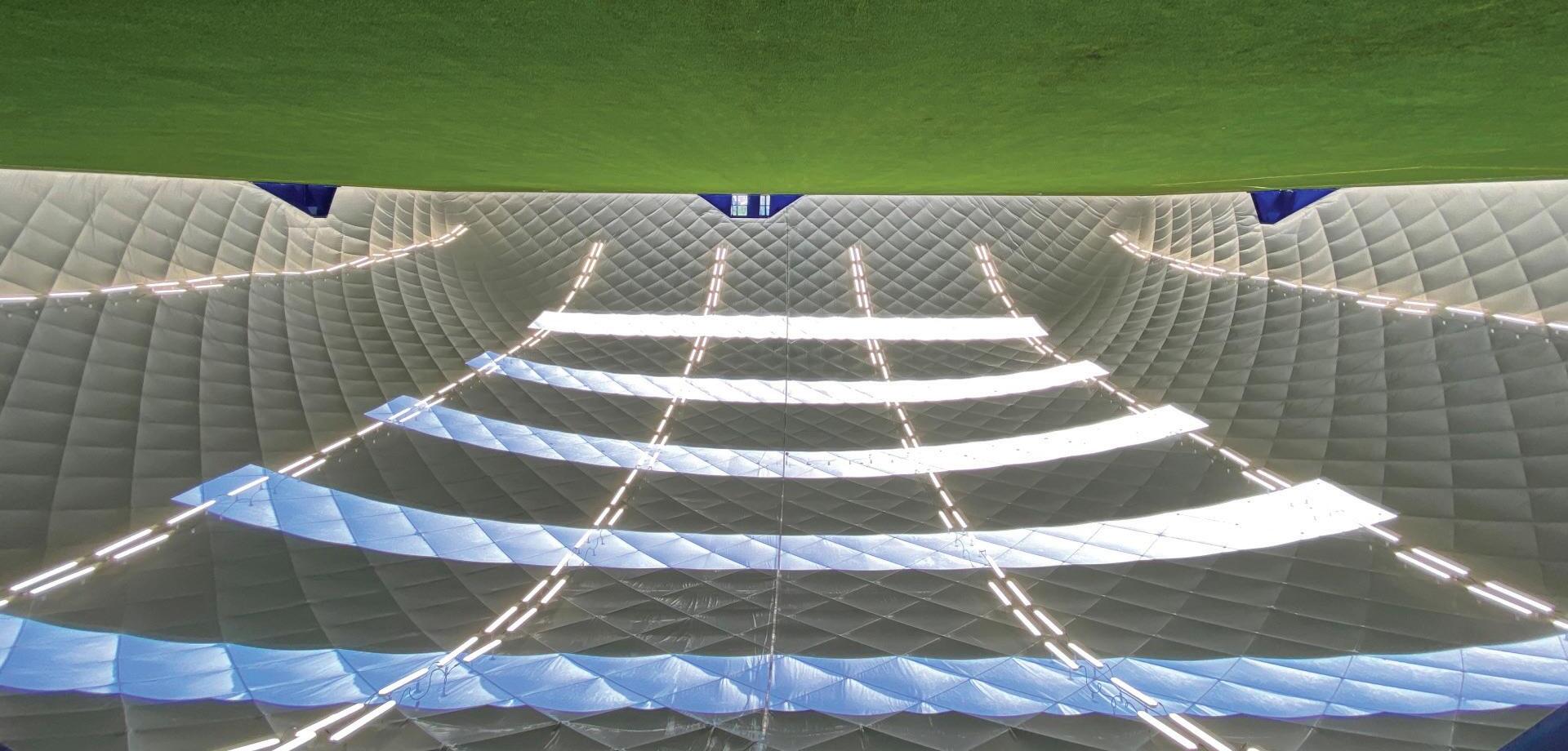
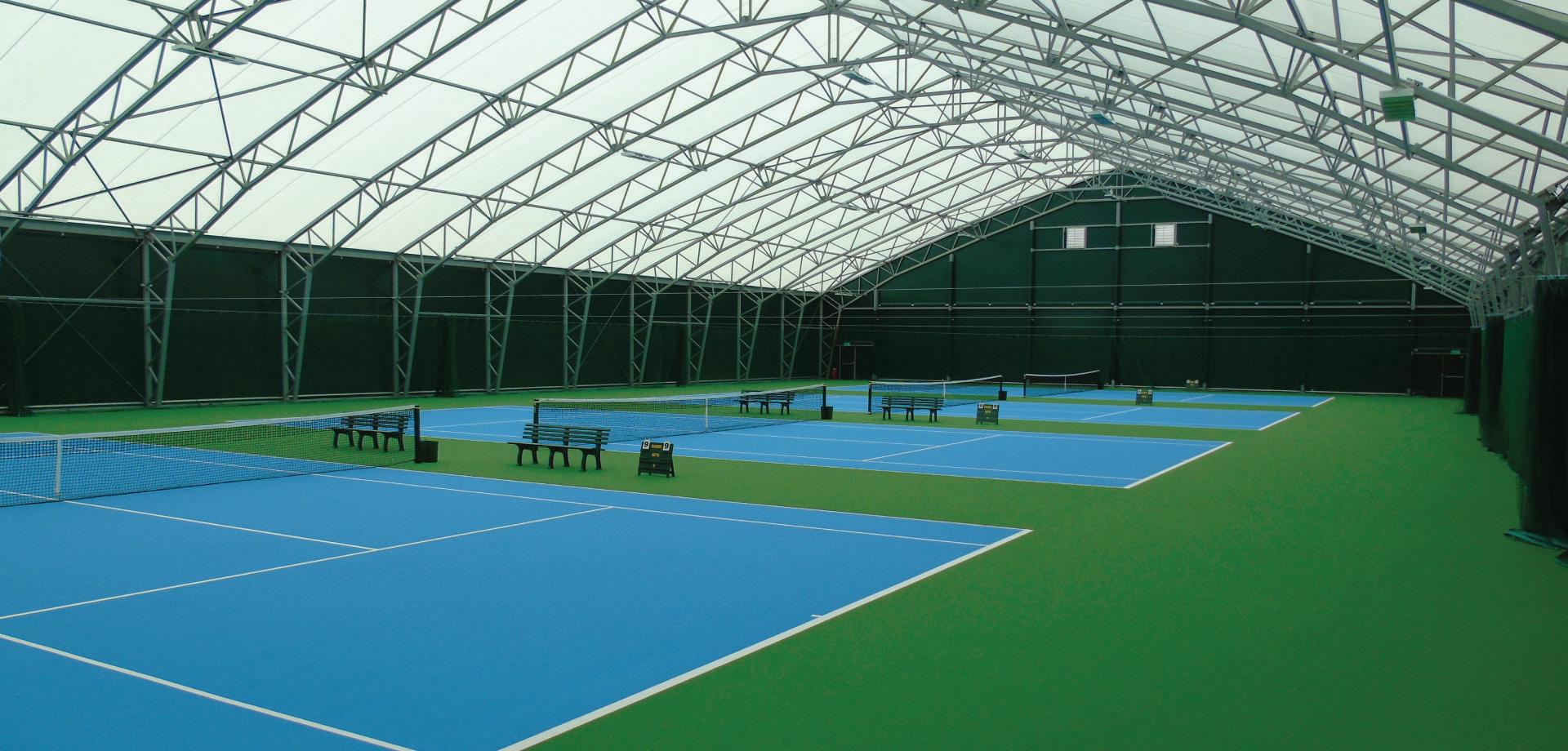
























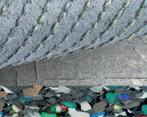








































I’ve worked at O’Brien Contractors since 2010, when I joined as a project manager within the civils side of the business. However, as the company’s sport division expanded, my responsibilities enveloped these works too.





















I get involved with projects during the tender phase. Once secured, it is my responsibility to ensure that the project is delivered safely, to the right quality, within budget and on time. I am also responsible for communicating with all stakeholders, including our clients, subcontractors, suppliers, and the local community.
I currently look after a number of projects across the Midlands for clients ranging from private developers to schools and colleges. I report directly to the project directors and report monthly on the progress of each individual project.
Although my background is mainly civil engineering, for the past six years I have delivered sports related projects. Works have included the regeneration of existing synthetic pitches, new synthetic pitches and local infrastructure and facilities. I have also been involved with the construction of new natural pitches for private clients, schools, and colleges.

The biggest challenges we face at the moment
are linked to the current economic climate. From the increasing costs of materials to the availability of resources, they make planning a challenge. Fortunately, our 65 years of trading has allowed us to build robust relationships with our subcontract and supply chain partners which helps overcome these challenges when they arise.
Seeing a sports project go from conception all the way through to completion, then seeing the facilities being used and enjoyed.






We’ve been delivering groundworks, enabling works and civil engineering solutions to both public and private sector clients for 65 years this year. We employ all of our own staff and invest heavily in our plant and technology. This enables us to offer a unique turnkey solution to our clients, helping them get their projects out of the ground.

A few years ago, our business strategy changed and saw us evolve from delivering mainly sub-contractor work to working as a main contractor for our clients. This allowed us to develop long lasting relationships with all

Roche joined O’Brien in 2010 as project manager
stakeholders from consultants to end clients. In turn, this has resulted in O’Brien Contractors enjoying repeat business, especially within the sports sector.
What do you see as the main opportunities and challenges for the sports and play construction in general?
Funding of sports and play construction has always been difficult – and due to the current economic climate, I can only see this becoming even more of a challenge. However, our approach to early engagement has supported our clients’ fundraising efforts and given them reassurance that their projects will be delivered on time and within budget. Early engagement also helps build confidence across all parties and has resulted in us securing future projects via negotiation. l
In February 2023, O’Brien Contractors was named winner of the SAPCA Award for a large sports and play construction project in the UK. The company developed 17 acres of former farmland into a sports facility for Old Saltleians RFC. The club’s new home now features six natural turf pitches, a clubhouse and associated infrastructure.

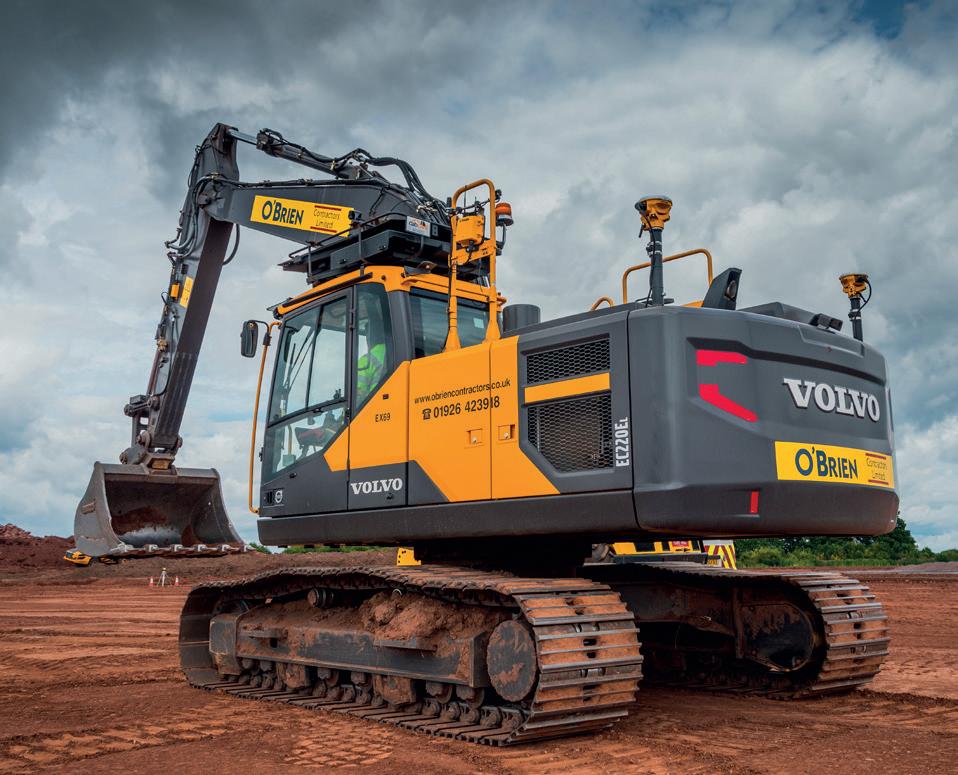

The company’s projects include stadiums and arenas for rugby, football and hockey

We employ all of our own staff and invest heavily in our plant and technologyO’Brien offers turnkey solutions for a wide range of sports facilities
STATE-OF-THE-ART FACILITIES FREE PARKING & WIFI

EXPERT IN-HOUSE COACHES FLEXIBLE MEMBERSHIPS & SO MUCH MORE!





FOURTH AVE, HORNBEAM PARK AVE, HARROGATE HG2 8QT 01423 224 752
UNIT 1, LODGE CAUSEWAY
TRADING ESTATE, FISHPONDS, BRISTOL BS16 3JB 0117 450 5199
